Management, Revised Edition
by Peter Drucker with Joseph A. Maciariello
See rlaexp.com initial bread-crumb trail — toward the
end of this page — for a site “overview”
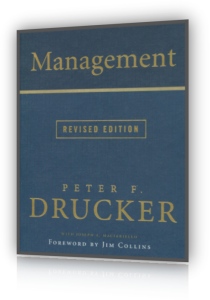 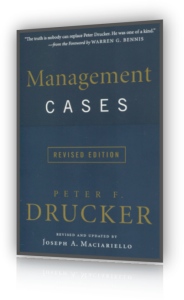
Amazon Links: Management Rev Ed and Management Cases, Revised Edition and Management Cases, Revised Edition
Contents list for Management Cases, Revised Edition
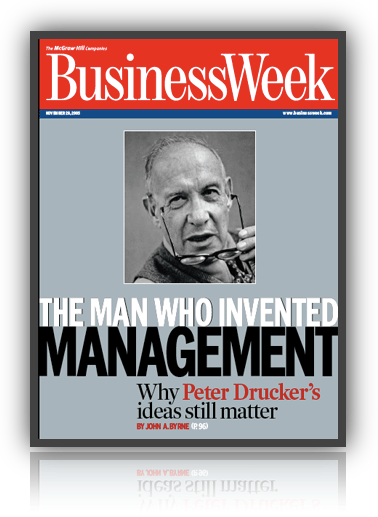
“Management, in most business schools, is still taught as a bundle of techniques, such as the technique of budgeting.
To be sure, management, like any other work, has its own tools and its own techniques.
But just as the essence of medicine is not the urinalysis, important though it is, the essence of management is not techniques and procedures.
The essence of management is to make knowledge productive.
Management, in other words, is a social function.
And in its practice, management is truly a “liberal art.” ”
From “A Century of Social Transformation”

About management
… It also follows that managing a business must be a creative rather than an adaptive task.
The more a management creates economic conditions or changes them rather than passively adapts to them, the more it manages the business (same concept applies to non-business institutions)—Management: Tasks, Responsibilities, Practices.
More on this theme in “Management”

This is a WHAT TO DO book not “how to do it.”
It is not just for reading, but for doing—what and when at multiple points in the future.
Information is not enough, thinking is needed and Thinking broad and Thinking detailed

Don't memorize, calendarize
This book doesn’t offer fine-tuning tips and techniques to superimpose on an existing organization.
It is not about how to operate a better blacksmith or candle-making shop, run a railroad, or improve AT&T of the 1960s—that’s so yesterday.
All of the preceding are gone—and for a reason. They outlived their usefulness.
This book addresses being a core organization in a “society of organizations” moving in time.
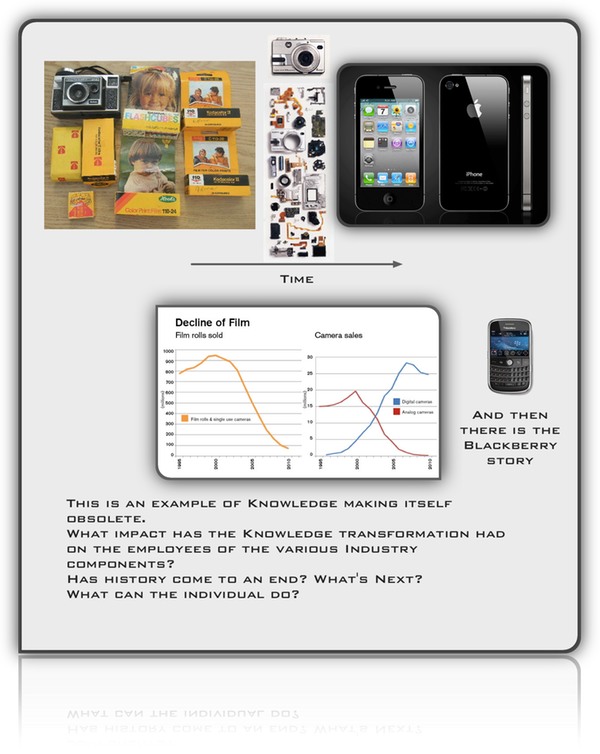
This is a book about making a contribution to society—a contribution that matters at different points in the future.
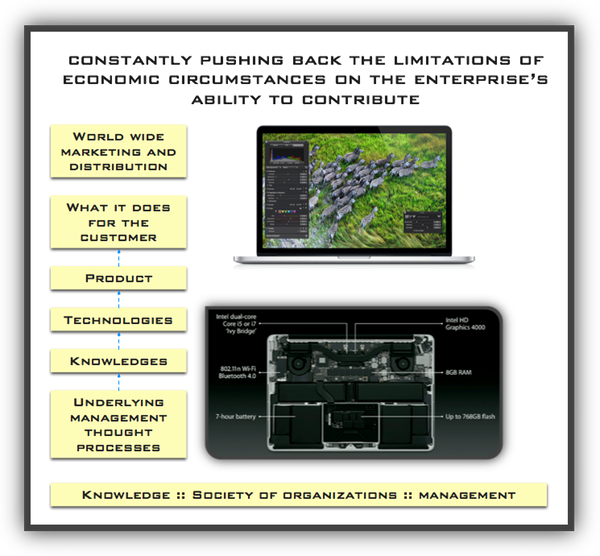
The vacuum that many inside-out institutions filled no longer exists and they need to move on.
You might want to evaluate your performance level in each of the topic areas below.
Are you world-class?
Are you number 1 or 2 in the world?
Do you have world-class management practices?
What about tomorrowS?
What are the questions that you need to ask?
Good football coaches have a playbook—plays they have thought out in advance.
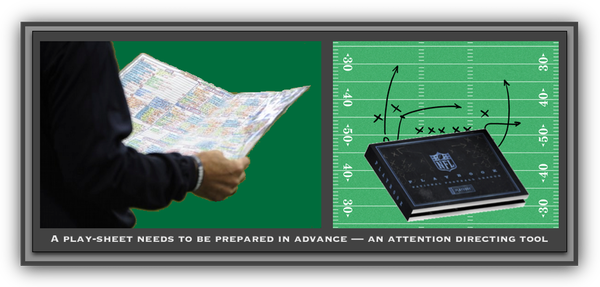
They also have a play sheet they carry along the side lines.
They have to use experience and judgement in which actual plays to use.
There has to be constant adjustment to the actual situation.
These ideas also apply in a society of organizations, but there are gigantic differences.
Unforeseen competitors and challenges can come from nowhere.
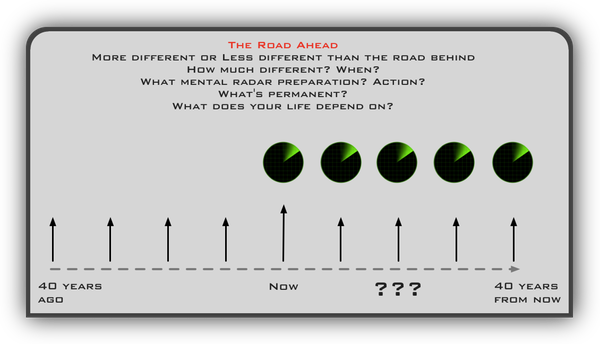
 Victims of success Victims of success
 How Hewlett-Packard Lost the HP Way (Three CEOs in six years, boardroom changes, and other contributers to disfunction) How Hewlett-Packard Lost the HP Way (Three CEOs in six years, boardroom changes, and other contributers to disfunction)
 Who Says Elephants Can’t Dance?: Leading a Great Enterprise (IBM) through Dramatic Change starting with their near bankruptcy. Who Says Elephants Can’t Dance?: Leading a Great Enterprise (IBM) through Dramatic Change starting with their near bankruptcy.
 Amazon link: How The Mighty Fall: And Why Some Companies Never Give In Amazon link: How The Mighty Fall: And Why Some Companies Never Give In
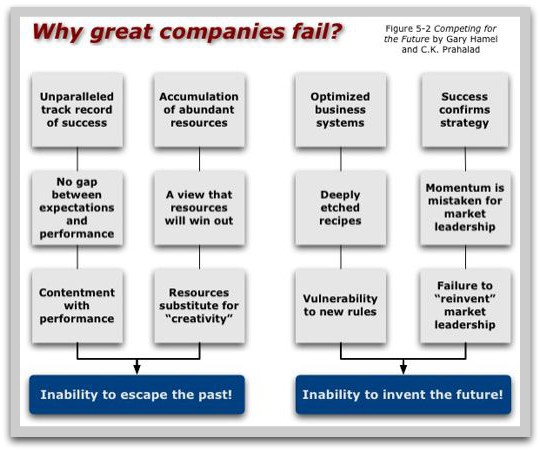
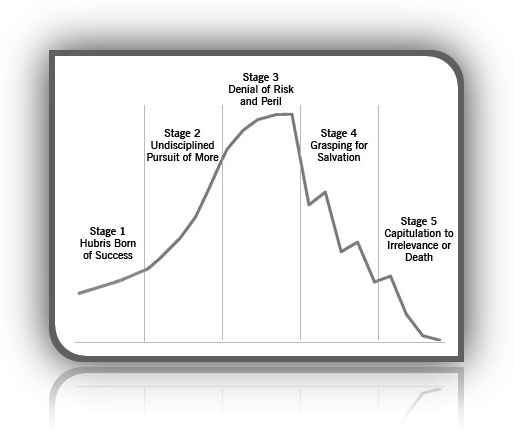
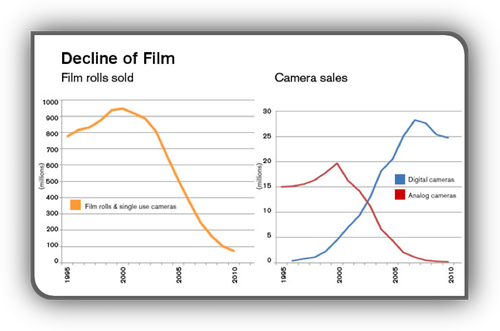

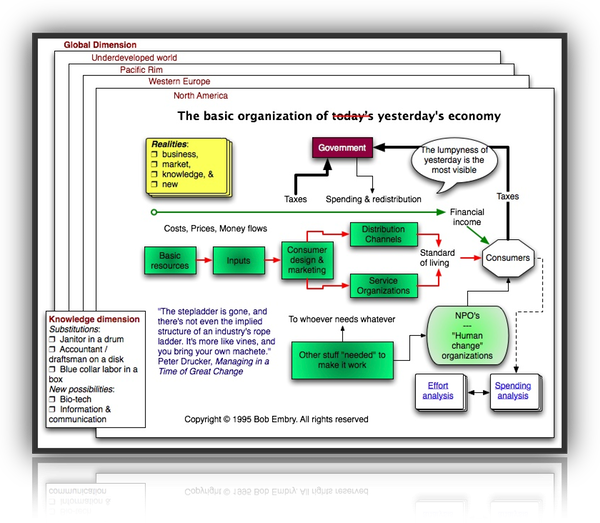
More economic landscape vistas
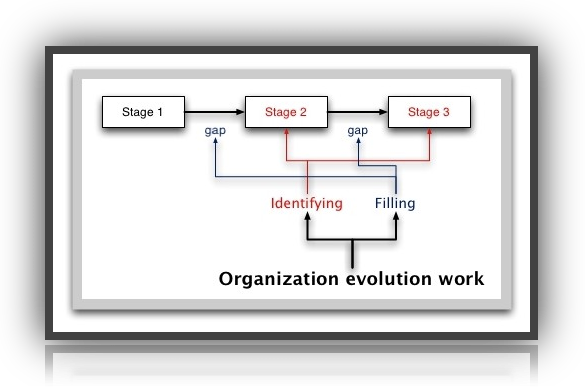

About Peter Drucker
Remembering Drucker (Four years after his death, Peter Drucker remains the king of the management gurus) from The Economist

An operational work sequence is different from the chapter sequence.
Getting the right people on board ::: Effective decisions
Contents of Revised Edition of Management: Tasks, Responsibilities, Practices by Peter Drucker
Chapter summaries PDF
What thinking is needed to make this ↑ ↓ operational?
- Title & Copyright Information
- Peter Drucker most important contribution
- Contents
- Peter Drucker's Legacy (leadership etc.)
- Introduction to the Revised Edition of Management: Tasks, Responsibilities, Practices
- The Origins of This Book
- How To Use This Book
- Management As A System Of Interrelated Elements (Figure 1)
- The Spirit Of Performance (Chapter 27)
- The Theory Of The Business (Chapter 8)
- Identifying Environmental Trends And The Future That Has Already Happened (Chapters 4-7, 10, Part 4)
- Social Impacts And Social Responsibilities (Chapters 20-21)
- Creative Destruction And Innovation And Entrepreneurship (Part 8)
- Managerial Skills, Managerial Tasks, And Personal Skills
- Managerial Skills (Chapters 28-33)
- Effective managers make effective decisions
- People decisions are a special case of decision making requiring their own rules
- Remaining four areas of managerial skills that executives must acquire to carry out their tasks
- Managers must learn to be good communicators
- Budgeting is the most widely used tool of management
- Creating appropriate measurements and maintaining control
- Organizing information for decision making
- Management Tasks (Chapters 9-11, 24-26, Part 9, Chapter 45)
- The theory of the business & MBO
- Organizing
- A manager must also motivate and communicate
- Establish yardsticks of performance
- Managing oneself and one's career and developing others
- Personal Skills (Part 10)
- Summary
- Preface!!!!!
- 1 Introduction: Management and Managers Defined
- What Is Management?
- Who Are The Managers?
- The New Definition Of A Manager
- What Do Managers Do?
- Most Managers Spend Most of Their Time on Things That Are Not "Managing"
- There are five basic operations in the work of the manager
- Set objectives
- Organizes
- Motivates and Communicates
- Measures
- Develops People—Including Himself or Herself
- Every one of these categories can be divided further into subcategories
- Every Category Requires Different Qualities and Qualifications
- Only a Manager's Experience Can Bring Them to Life and Make Them Concrete and Meaningful
- The Manager's Resource: People
- Management: A Practice, Not A Science
- Note: The Roots And History Of Management
- The Early Economists
- The Emergence Of Large-Scale Organization
- The First Management Boom
- The Work Of The 1920s And 1930s
- Summary
- 2 Management as a Social Function and Liberal Art
- The Emergence of Management
- Management As The Agent Of Transformation
- Management And Entrepreneurship
- The Accountability Of Management
- What Is Management?
- A bundle of analytical tools like those taught in business schools?
- A Very Few, Essential Principles
- Management is about human beings. Its task is to make people capable of joint performance, to make their strengths effective and their weaknesses irrelevant.
- It is deeply embedded in culture
- Commitment to common goals and shared values. Management's first job is to think through, set, and exemplify those objectives, values, and goals
- Training and development that never stop
- Communication and individual responsibility
- An organization needs a diversity of measures to assess its health and performance
- Results Exist Only on the Outside
- The Path to Becoming Achieving, Accomplished Managers
- Management As A Liberal Art
- Summary
- 3 The Dimensions of Management
- Institutions and Management Are Organs of Society
- Defining Management Through its Tasks
- Mission
- Productive Work And Worker Achievement
- Social Responsibilities
- Which Task Is Most Important?
- The Time Dimension
- Administration And Entrepreneurship
- Summary
- Part I: Management's New Realities
- 4 Knowledge Is All
- Knowledge Is the Key Resource in Society and Knowledge Workers Are the Dominant Group in the Workforce
- The Three Main Characteristics of (a/the) Knowledge Economy
- Borderlessness, because knowledge travels even more effortlessly than money.
- Upward mobility, available to everyone through easily acquired formal education.
- The potential for failure as well as success. Anyone can acquire the "means of production"—that is, the knowledge required for the job—but not everyone can win.
- The New Workforce
- The terms knowledge industries, knowledge work and knowledge worker are nearly fifty years old.
- They were coined around 1960, simultaneously but independently— the first by a Princeton economist, Fritz Machlup, the second and third by this writer.
- Now everyone uses them, but as yet hardly anyone understands their implications for human values and human behavior, for managing people and making them productive, for economics, and for politics.
- What is already clear, however, is that the emerging knowledge society and knowledge economy will be radically different from the society and economy of the late twentieth century
- His And Hers
- Ever Upward
- The Price Of Success
- Summary
- 5 New Demographics
- The Sifting Age Structure
- Needed But Unwanted
- A Country of Immigrants
- Splitting of Hitherto Homogeneous Societies and Markets
- The End of the Single Market
- Beware Demographic Changes
- Summary
- 6 The Future of the Corporation and the Way Ahead
- Five OUTDATED Basic Assumptions
- The corporation is the "master," the employee is the "servant."
- The great majority of employees work full-time for the corporation
- All activities under one management
- Suppliers have market power
- Technologies and industries are a unique set
- Everything In Its Place (Five NEW Assumptions)
- The means of production is knowledge, which is owned by knowledge workers and is highly portable
- A growing number of people who work for an organization will not be full-time employees
- There always were limits to the importance of transactional costs
- The customer now has the information
- There are few unique technologies anymore
- Who Needs A Research Lab?
- The Next Company
- From Corporation To Confederation
- General Motors Example
- The Toyota Way
- A Large Manufacturer of Branded and Packaged Consumer Goods
- There Are Already a Good Many Variations on This Theme
- The Syndicate Model
- Top management's role
- Life At The Top
- The Way Ahead: The Time To Get Ready For The New Realities Is Now
- The future corporation
- People policies
- Outside information
- Change agents
- To survive and succeed, every organization will have to turn itself into a change agent.
- The most effective way to manage change successfully is to create it.
- But experience has shown that grafting innovation onto a traditional enterprise does not work.
- The enterprise has to become a change agent.
- This requires the organized abandonment of things that have been shown to be unsuccessful …
- The organized and continuous improvement of every product, service, and process within the enterprise (which the Japanese call kaizen).
- It requires the exploitation of successes, especially unexpected and unplanned-for ones
- It requires systematic innovation.
- The point of becoming a change agent is that it changes the mindset of the entire organization.
- Instead of seeing change as a threat, its people will come to consider it as an opportunity.
- And Then?
- Information revolution in historical context
- The two industrial revolutions also bred new theories and new ideologies
- Big Ideas
- New Economic Regions
- Transnational financial organizations
- Schumpeter's postulates of dynamic disequilibrium
- The World of 2030: very different
- Summary
- 7 Management's New Paradigm
- Introduction (About Assumptions)
- Management Is Business Management — NOT!
- The One Right Organization — NOT!
- The One Right Way To Manage People — NOT!
- Technologies And End-Users Are Fixed And Given — NOT!
- Management's Scope Is Legally Defined — NOT!
- Management's Scope Is Politically Defined — NOT!
- The Inside Is Management's Domain — NOT!
-
Final paradigm: Management's Concern and Responsibility — Management is the specific tool, the specific function, the specific instrument, to make institutions capable of producing results (on the outside).
This, however, requires a final new management paradigm:
Management's concern and management's responsibility are everything that affects the performance of the institution and its results — whether inside or outside, whether under the institution's control or totally beyond it. (core work toward — calendarize this?)
- Summary
- Part II: Business Performance
- 8. The Theory of the Business PDF (in depth)
- 9 The Purpose and Objectives of a Business PDF
- The failure to understand the nature, function, and purpose of business enterprise
- To know what a business is, we have to start with its purpose
- Its purpose must lie outside of the business itself
- In fact, it must lie in society, since business enterprise is an organ of society.
- There is only one valid definition of business purpose: to create a customer
- It is the customer who determines what a business is
- The Purpose Of A Business
- Two basic functions: marketing and innovation (it ain't what you think)
- The reality of today's organization
- What is Our Business? (Product and service names are not allowed. We're in the computer, airline, banking or retailing business misses the point. It doesn't define a specific contribution)
- Who is the Customer is the Starting Point
- Where is the customer?
- What does the customer buy?
- When to ask: What is our business?
- And what will it be?
- "What Should Our Business Be?"
- Planned, systematic abandonment
- Systematic analysis of all existing products, services …
- Defining the purpose and mission enables a business to be managed for performance
- The basic definition of the business and of its purpose and mission have to translated into objectives
- Objectives must be derived from "what our business is, what it will be, and what it should be." (Product and service names are not allowed. We're in the computer, airline, banking or retailing business misses the point. It doesn't define a specific contribution)
- Objectives must be operational
- Objectives must make possible concentration of resources and efforts
- There must be multiple objectives rather than a single objective
- Objectives are needed in all areas on which the survival of the business depends
- Areas that need objectives
- Objectives are the basis for work and assignments
- Objectives are always needed in all eight key areas
- Measurements are needed in all areas (see chapter 31 — Controls, Control, and Management)
- How to use objectives
- Marketing Objectives
- Two key decisions
- Area of concentration
- Market standing
- The Innovation Objective (relating to the existing business)
- Resources Objectives
- Productivity Objectives
- The Social Responsibility Objectives
- Profit: A Need And Limitation
- Balancing Objectives
- From Objectives To Doing
- Summary
- 10 Making the Future Today
- We know only two things about the future
- Far-reaching implications
- Managers must accept the need to work systematically on making the future
- The Future That Has Already Happened
- The Power of an Idea
- Creativity (its not what you think it is)
- Summary
- 11 Strategic Planning: The Entrepreneurial Skill
- What Strategic Planning Is Not
- It is not a box of tricks, a bundle of techniques
- Strategic planning is not forecasting
- Strategic planning does not deal with future decisions, but the futurity of present decisions
- Strategic planning is not an attempt to eliminate risk
- What Strategic Planning Is
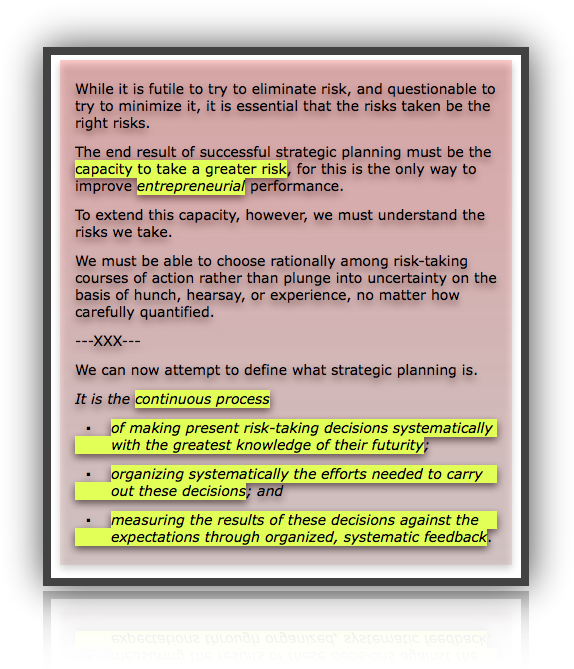
- Sloughing Off Yesterday
- What New Things Do We Have To Do — When?
- To sum up
- Everything Degenerates Into Work
- Summary
- See Mike Kami's Strategic Planning Manual
- Part III: Performance in Service Institutions
- 12 Managing Service Institutions in the Society of Organizations
- The Multi-Institutional Society
- Are Service Institutions Managed?
- But Are They Manageable?
- Managing Public-Service Instituiions For Performance
- They need to define "what our business is and what it should be."
- They must derive clear objectives and goals from their definition of function and mission
- They then must set priorities that enable them to …
- They must define measurements of performance
- They must use these measurements to feed back on their efforts
- They need an organized review of objectives and results, to weed out those objectives that no longer …
- To make service institutions perform it requires a system
- The applications of the essentials differ greatly for different service institutions. See Managing the Non-Profit Organization
- The Three Kinds Of Service Institutions
- Natural Monopoly
- Paid for Out of a Budget Allocation
- The Service Institution in Which Means Are as Important as Ends
- The Institutions' Specific Need
- The Natural Monopoly
- Socialist Competition in the Service Sector
- The Institutions of Governance
- Conclusion: What the service institutions need is not to be more businesslike
- Summary
- 13 What Successful and Performing Non profits Are Teaching Business
- A Commitment To Management
- Effective Use Of The Board
- To Offer Meaningful Achievement
- Training, Training, Training
- A Warning To Business: in my job there isn't much challenge, not enough achievement, not enough responsibility; and there is no mission, there is only expediency
- Managing the knowledge worker for productivity is the challenge ahead for American management.
- The nonprofits are showing us how to do that.
- It requires
- A clear mission
- Careful placement
- Continuous learning and teaching
- Management by objectives and self-control — see chapter 25 below
- High demands but corresponding responsibility and accountability for performance and results
- Summary
- 14 The Accountable School
- The New Performance Demands
- Learning To Learn
- The School In Society
- The Accountable School
- Summary
- 15 Rethinking "Reinventing Government"
- Restructuring
- Rethinking
- Abandoning
- An Exception For Crusades
- Government That's Effective
- Postscript
- Summary
- 16 Entrepreneurship in the Public-Service Institution
- Introduction
- Main reasons why the existing enterprise presents so much more of an obstacle to innovation
- The public-service institution is based on a "budget" rather than on being paid out of its results
- A service institution is dependent on a multitude of constituents
- Public-service institutions exist, after all, to "do good."
- These are serious obstacles to innovation
- There are enough exceptions to show that public-service institutions can innovate
- The entrepreneurial policies needed to make it capable of innovation
- The Need to Innovate
- Summary
- Part IV: Productive Work and Achieving Worker
- 17 Making Work Productive and the Worker Achieving
- Work And Worker In Rapid Change
- The Crisis Of The Manual Worker
- The Crisis Of The Union
- Unions And The Knowledge Workers
- Managing The Knowledge Worker: The New Challenge
- The Segmentation Of The Workforce
- The New Breed
- Summary
- 18 Managing the Work and Worker in Manual Work
- The Productivity Of The Manual Worker
- The Principles Of Manual-Work Productivity
- The Future Of Manual-Worker Productivity
- Summary
- 19 Managing the Work and Worker in Knowledge Work
- What We Know About Knowledge-Worker Productivity
- What Is The Task?
- The Knowledge Worker As Capital Asset
- The Technologists
- Knowledge Work As A System
- What to do about knowledge-worker productivity is thus largely known
- But How To Begin?
- The Governance Of The Corporation
- Summary
- Part V: Social Impacts and Social Responsibilities
- 20 Social Impacts and Social Responsibilities
- Responsibility For Impacts
- How To Deal With Impacts
- When Regulation Is Needed
- Social Problems As Business Opportunities
- The Limits Of Social Responsibility
- The Limits Of Authority
- The Ethics Of Responsibility
- Summary
- 21 The New Pluralism: How to Balance the Special Purpose of the Institution with the Common Good
- A Brief View Back
- Why We Need Pluralism
- Leadership Beyond The Walls
- Three Dimensions To This Integration
- Above All: Two Responsibilities
- Summary
- Part VI: The Manager's Work and Jobs
- 22 Why Managers?
- The Rise, Decline, And Rebirth Of Ford—A Controlled Experiment In Mismanagement
- GM—The Counter Test
- The Lesson Of The Ford Story
- Management As A "Change Of Phase"
- Summary
- 23 Design and Content of Managerial Jobs
- Guiding concepts
- Common Mistakes In Designing Managerial Jobs
- 1. The too-small job
- 2. The nonjob
- 3. Failing to balance managing and working
- 4. Poor job design
- 5. Titles as rewards
- 6. The widow-maker job
- Job Structure And Personality
- The Span Of Managerial Relationships
- Defining A Manager's Job
- Specific function
- Assignments
- Relationships
- Information needed for the job and by a manager's place in the information flow
- These four definitions, which together describe a manager's job, are the manager's own responsibility
- The Manager's Authority
- Managers, Their Superiors, Their Subordinates, And The Enterprise
- Summary
- 24 Developing Management and Managers
- Why Management Development?
- Why Manager Development?
- What Management Development Is Not
- Not taking courses
- Not promotion planning, replacement planning, or finding potential
- Not means to "make people over" by changing their personalities
- The Two Dimensions Of Development
- Summary
- 25 Management by Objectives and Self-Control (PDF)
- Four factors that tend to misdirect
- The Specialized Work Of Managers
- Misdirection By Hierarchy
- Misdirection can result from a difference in concern between various levels of management
- Misdirection By Compensation
- What Should The Objectives Be?
- Management By Drives
-
How Should Objectives Be Set and By Whom?
They have each of their subordinates write a manager's letter twice a year.
In this letter to the superior, managers first define the objectives of the superior's job and of their own job, as they see them.
They then set down the performance standards that they believe are being applied to them.
Next, they list the things they must do to attain these goals and the things within their own units they consider the major obstacles.
They list the things the superiors and the company do that help them and the things that hamper them.
Finally, they outline what they propose to do during the next year to reach their goals.
If their superiors accept this statement, the manager's letter becomes the charter under which the manager operates.
This device, like no other I have seen, brings out how easily the unconsidered and casual remarks of even the best boss can confuse and misdirect.
One large company has used the manager's letter for ten years.
Yet almost every letter still lists as objectives and standards things that baffle the superior to whom the letter is addressed.
And whenever she asks, "What is this?" she gets this sort of answer, "Don't you remember what you said last spring going down in the elevator with me?"
The manager's letter also brings out whatever inconsistencies there are in the demands made on a person by his or her superior and by the company.
Does the superior demand both speed and high quality when she can get only one or the other?
And what compromise is needed in the interest of the company?
Does the boss demand initiative and judgment of her people but also that they check back with her before they do anything?
Does the superior ask for ideas and suggestions but never uses them or discusses them?
Does the company expect of a small engineering force that it be available immediately whenever something goes wrong in the plant and yet bend all its efforts to the completion of new designs?
Does it expect managers to maintain high standards of performance but forbid them to remove poor performers?
Does it create the conditions under which people say, "I can get the work done as long as I can keep the boss from knowing what I am doing"?
As the manager's letter illustrates, managing managers requires special efforts not only to establish common direction, but to eliminate misdirection.
Mutual understanding can never be attained by "communications down," can never be created by talking.
It results only from "communications up."
It requires both the superior's willingness to listen and a tool especially designed to make lower managers heard.
- Self-Control Through Measurements
- Self-Control And Performance Standards
- A Philosophy Of Management
- Summary
- 26 From Middle Management to Information-Based Organizations
- Information Technology
- From Data To Information
- Converting Data Into Information Thus Requires Knowledge
- Content and Structure of the Information-Based Organization
- The British in India
- Requirements and Management Problems of the Information-Based Organization
- Requirements
- Special Management Problems
- Developing Rewards, Recognition, and Career Opportunities for Specialists
- Creating Unified Vision in an Organization of Specialists
- Devising the Management Structure for an Organization of Task Forces
- Ensuring the Supply, Preparation, and Testing of Top Management People
- Evolutions in the Concept and Structure of Organizations
- From Ownership to Management
- Command-and-Control Organization of Today
- The Organization of Knowledge Specialists
- Summary
- 27 The Spirit of Performance PDF
- The Danger Of Safe Mediocrity
- "Conscience" Decisions
- Focus On Opportunity
- "People" Decisions—The Control Of An Organization
- Integrity, The Touchstone
- Leadership And The Spirit Of Performance
- Leadership "Qualities"?
- The Undoing Of Leaders
- Earning Trust Is A Must
- Summary
- Part VII: Managerial Skills
- 28 The Elements of Effective Decision Making PDF
- Practices of Good Decision Makers
- The Elements Of Decision Making
- Determine Whether A Decision Is Necessary
- The Rules Used by Surgeons to Make Decisions
- The Recurring Crisis
- Classify The Problem
- Define The Problem
- Example
- The one way to make sure that the problem is correctly defined
- Decide On What Is Right
- Get Others To Buy The Decision
- 1. Japanese Decision-Making Process
- 2. Franklin Roosevelt's Decision Process
- Build Action Into The Decision
- Converting a Decision to Action
- Example: rationalize production
- Example: redesign instruments so they are easy to service
- Test The Decision Against Actual Results
- Summary: Seven Steps to Minimize Risks Inherent in Every Decision
- Building Continuous Learning Into Executive Decisions
- Summary
- 29 How to Make People Decisions
- Making People Decisions
- The Five Decision Steps
- Carefully think through the assignment
- Look at several qualified people
- Study the performance records of all three to five candidates to find what each does well
- Discuss the candidates with others who had worked with them
- Make sure the appointee understands the assignment
- Alfred P. Sloan, Jr., achieved a near perfect record in making people decisions
- The Five Ground Rules
- The manager must accept responsibility for any placement that fails
- The manager has the responsibility to remove people who do not perform
- Give nonperformers a second chance
- Try to make the right people decisions for every position
- Newcomers are best put into an established position where the expectations are known and help is available
- The High-Risk People Decisions
- What do I have to do now to be successful in this new assignment?
- The Widow-Maker Position
- Build Feedback Control Into People Decisions
- The Power Of Making People Decisions
- Summary
- 30 Managerial Communications
- 31 Controls, Control, and Management PDF
- The Characteristics Of Controls
- 1. Controls can be neither objective nor "neutral."
- 2. Controls need to focus on results
- 3. Controls are needed for measurable and nonmeasurable events
- Specification For Controls
- 1. Control is a principle of economy
- 2. Controls must be meaningful
- 3. Controls have to be appropriate to the character and nature of the phenomenon measured
- 4. Measurements have to be congruent with events measured
- 5. Controls have to be timely
- 6. Controls need to be simple
- 7. Finally, controls must he operational
- The Ultimate Control Of Organization
- Summary
- 32 The Manager and the Budget PDF
- The Budget Is A Managerial Tool
- Zero-Based Budgeting
- Types Of Cost
- Life-Cycle Budgeting
- Operating Budget And Opportunities Budget
- Budgeting Human Resources
- Budgeting And Control
- The Gantt Chart And Network Diagrams
- Judging Performance By Using The Budget
- Summary
- 33 Information Tools and Concepts
- 1. Foundation Information That Enterprises Need
- From Cost Accounting to Result Control
- From Legal Fiction to Economic Reality
- 2. Information For Wealth Creation
- Productivity Information
- Competence Information
- Resource-Allocation Information
- Where the Results Are
- 3. Information That Managers Need For Their Work
- No Surprises
- Going Outside
- Summary
- Part VIII: Innovation and Entrepreneurship
- 34 The Entrepreneurial Business
- Structures
- The new, has to be organized separately from the old and existing
- A special, high up locus is needed
- Burdens it cannot yet carry
- The Don'ts
- Don't mix managerial units and entrepreneurial ones
- Innovation had better not be "diversification."
- Acquisitions rarely work unless …
- Summary
- 35 The New Venture
- The Need For Market Focus
- Financial Foresight
- Building a Top Management Team
- "Where Can I Contribute?"
- The Need For Outside Advice
- Summary
- 36 Entrepreneurial Strategies
- Being "Fustest With The Mostest"
- Hitting Them Where They Ain't (Creative Imitation & Entrepreneurial Judo)
- Creative Imitation
- Entrepreneurial Judo
- The Five Bad Habits That Enable Newcomers to Use Entrepreneurial Judo
- 1. The first is what American slang calls NIH ("not invented here")
- 2. The second is the tendency to "cream" a market
- 3. Even more debilitating is the third bad habit: the belief in "quality."
- 4. The delusion of the "premium" price
- 5. They maximize rather than optimize
- Entrepreneurial judo aims first at securing a beachhead—and then the whole "island"
- Entrepreneurial judo requires some degree of genuine innovation
- Entrepreneurial judo "hits them where they ain't"
- Ecological Niches
- The Toll-Gate Strategy
- The Specialty-Skill Strategy
- The Speciality-Market Strategy
- Changing Values And Characteristics
- Creating Customer Utility
- Pricing
- Adapting to Customer Reality
- Delivering Value to the Customer
- Elementary Marketing
- Summary
- 37 Systematic Innovation Using Windows of Opportunity
- Seven Windows Of Opportunity
- 1. Unexpected successes ::: unexpected failures ::: unexpected events
- 2. Incongruities
- 3. Process needs
- 4. Changes in industry and market structures
- 5. Changes in demographics
- 6. Changes in meaning and perception
- 7. And finally: new knowledge
- A change in any one of these seven windows of opportunity raises the question …
- Innovation is not "flash of genius."
- Piloting
- Summary
- Part IX: Managerial Organization
- 38 Strategies and Structures
- Yesterday's Final Answers
- Traditional Assumptions And Current Needs
- Then vs. now
- Different types of businesses
- More complex, more diverse
- Global reach
- Different information flows
- Different types of workers
- More entrepreneurial
- What we now know
- Organization design and structure require thinking, analysis, and a systematic approach
- The first step is identifying and organizing the building blocks of organization
- Structure follows strategy
- The Three Kinds of Work: Top Management, Operating, Innovation
- What We Need To Unlearn
- The sham battle between task focus and person focus in job design and organization structure
- Hierarchical, or scalar, versus free-form organization
- One best principle alone is "right" and that it is also always "right."
- Instead of the "one right" principle
- The Building Blocks Of Organization
- The Key Activities
- In what area is excellence required to obtain the company's objectives?
- In what areas would nonperformance endanger the results, if not the survival, of the enterprise?
- What are the values that are truly important to us in this company?
- The key activities have to be identified, defined, organized, and centrally placed
- Business should always analyze its organization structure when its strategy changes
- The Contribution Analysis
- The "Conscience" Activities
- Making Service Staff Effective
- The Two Faces Of Information
- Housekeeping
- There is one overall rule
- The building blocks of organization
- Placing the structural units that make up the organization requires two additional pieces of work
- Decision Analysis
- What decisions are needed to obtain the performance objectives?
- Large company example: decisions had to "go looking for a home"
- Four basic characteristics determine the nature of any business decision
- Degree of futurity
- Impact a decision has on other functions
- Number of qualitative factors
- Decisions can be classified as periodically recurrent or rare
- Decision placement rules
- Relation Analysis
- Symptoms Of Poor Organization
- There is no perfect organization
- At its best, an organization structure doesn't cause trouble
- Mistakes and symptoms
- An increase in the number of management levels
- Recurring organizational problems
- An organization structure that puts the attention of key people on the wrong …
- Several common symptoms of poor organization that, usually, require no further diagnosis
- Too many meetings attended by too many people
- People are constantly concerned about feelings and about what other people …
- Overstaffed organizations create work rather than performance
- Relying on "coordinators," "assistants," and …
- "Organizitis" As A Chronic Affliction
- Summary
- Five Design Principles
- 39 Work- and Task-Focused Design
- Formal Specifications (for Organization Structure)
- 1. Clarity
- 2. Economy
- 3. The direction of vision
- 4. Understanding one's own task and the common task
- 5. Decision making
- 6. Stability and adaptability
- 7. Perpetuation and self-renewal
- Meeting The Specifications
- Three Ways Of Organizing Work
- Stages in the process
- The work moves to where the skill or tool required for each of the steps is located
- A team of workers with different skills and different tools moves to the work
- Functional organization organizes work both by stages and by skills
- In the "team structure," however, work and task are, so to speak, fixed
- Both functional and team structures are old designs
- Work and task have to be structured and organized
- The Functional Structure (and the specifications)
- Its Limited Scope (to operating work)
- Where Functionalism Works
- The Team
- The Requirements of Team Design
- The Strengths and Limitations of the Team Principles
- The Scope of Team Organization
- Team Design And The Knowledge Organization
- Summary
- 40 Three Kinds of Teams
- The first kind of team is the baseball team.
- The second kind of team is the football team
- The third kind of team is the tennis doubles team
- Observations on the baseball-style team
- Observations on the football-style team
- Observations on the doubles team
- Observations on theses teams
- Summary
- 41 Result- and Relation-Focused Design
- Federal Decentralization
- The Strength of Federal Decentralization
- The Requirements of Federal Decentralization
- Size Requirements
- How Small Is Too Small?
- What Is a "Business"?
- Simulated Decentralization
- The Problems of Simulated Decentralization
- Rules for Using Simulated Decentralization
- The Systems Structure
- The Difficulties and Problems of the Systems Structure
- Summary
- 42 Alliances
- Why Do Organizations Enter into Alliances?
- The Different Types of Alliances
- Common Problems Facing All Alliances and Their Resolution
- Managing Alliances As Marketing Partnerships
- Summary
- 43 The CEO in the New Millennium — here
- The Work Of The CEO: The Link Between The Inside And Outside
- The Tasks Of The CEO
- To define the meaningful outside of the organization
- To work on getting information from the 'outside' into usable form
- To decide what results are meaningful for the institution
- To decide the priorities
- To place people into key positions
- To organize top management
- The CEO: An American Invention And Export
- Summary
- 44 The Impact of Pension Funds on Corporate Governance (core work toward)
- Intro
- The rise of pension funds as dominant owners and lenders represents one of the most startling power shifts in economic history
- Demographics guarantee that these assets will continue to grow aggressively
- Two questions, in particular, demand attention:
- For what should America’s new owners, the pension funds, hold corporate management accountable?
- And what is the appropriate institutional structure through which to exercise accountability?
- Can't Sell
- “If one can’t sell, one must care.”
- Thus pension funds, as America’s new owners, will increasingly have to make sure that a company has the management it needs.
- It means that management must be accountable for performance and results, rather than for good intentions, however beautifully quantified.
- It means that accountability must involve financial accountability, even though everyone knows that performance and results go way beyond the financial “bottom line.”
- Surely, most people will say, we know what performance and results mean for business enterprise.
- We should of course, because clearly defining these terms is a prerequisite both for effective management and for successful and profitable ownership.
- Management For The Stakeholders
- What makes takeovers and buyouts inevitable (or at least creates the opportunity for them) is the mediocre performance of management, the management without clear definitions of performance and results and with no clear accountability to somebody.
- The raiders and buyout firms thus perform a needed function.
- As an old proverb has it, “If there are no grave diggers, one needs vultures.”
- But takeovers and buyouts are very radical surgery.
- And even if radical surgery is not life-threatening, it inflicts profound shock.
- For most people, “maximizing shareholder value” means a higher share price within six months or a year—certainly not much longer.
- Such short-term capital gains are the wrong objective for both the enterprise and its dominant shareholders.
- As a theory of corporate performance, then, “maximizing shareholder value” has little staying power.
- The interest of a large pension fund is in the value of a holding at the time at which a beneficiary turns from being an employee, who pays into the fund, to being a pensioner, who gets paid by the fund.
- Concretely, this means that the time over which a fund invests—the time until its future beneficiaries will retire—is on average thirty years rather than three months or six months.
- This is the appropriate return horizon for these owners.
- We no longer need to theorize about how to define performance and results in the large enterprise.
- … Rather, they maximize the wealth-producing capacity of the enterprise.
- It is this objective that integrates short-term and long-term results and that ties the operational dimensions of business performance—market standing, innovation, productivity, and people and their development—to financial needs and financial results.
- It is also this objective on which all constituencies depend for the satisfaction of their expectations and objectives, whether shareholders, customers, or employees.
- To define performance and results as maximizing the wealth-producing capacity of the enterprise may be criticized as vague.
- To be sure, one doesn’t get the answers by filling out forms.
- Decisions need to be made, and economic decisions that commit scarce resources to an uncertain future are always risky and controversial.
- Financial objectives are needed to tie all this together.
- Indeed, financial accountability is the key to the performance of management and enterprise.
- Without financial accountability, there is no accountability at all.
- And without financial accountability, there will also be no results in any other area.
- What we have is not the “final answer.”
- Still, it is no longer theory but proven practice.
- Institutional Structure For Accountability
- For while the business audit need not be conducted every year (every three years may be enough in most cases), it needs to be based on predetermined standards and go through a systematic evaluation of business performance, starting with mission and strategy, through marketing, innovation, productivity, people development, community relations, all the way to profitability — see chapter 9
- Still, the question remains, Who is going to use this tool?
- In the American context, there is only one possible answer: a revitalized board of directors.
- An Effective Board
- Spelling out its work
- Setting specific objectives for its performance and contribution
- Regularly appraising the board’s performance against these objectives.
- Summary
- Part X: New Demands on the Individual
- 45 Managing Oneself
- Now even people of modest endowments have to manage themselves
- Who am I?
- 1. What Are My Strengths?
- Am I A Reader Or A Listener?
- How Do I Learn?
- To manage oneself, one has to ask additional questions
- What Are My Values?
- What to Do in a Value Conflict
- 2. Where Do I Belong?
- 3. What Is My Contribution?
- 4. Relationship Responsibility
- Accepting that other people are as much individuals as one is oneself
- Take responsibility for communications
- Summary
- 46 Managing the Boss
- Most Of Us Have More Than One Boss
- The Boss Is Key To Effectiveness
- Neglect Of Managing The Boss
- Who Is The Boss?
- Managing The Boss
- 1. Making a Boss List
- 2. Asking for Input
- 3. Enabling Bosses to Perform
- 4. Playing to the Bosses' Strengths
- 5. Keeping Bosses Informed
- 6. Protecting Bosses from Surprises
- 7. Never Underrating Bosses
- Summary
- 47 Revitalizing Oneself-Seven Personal Experiences
- Experience One: Goal And Vision Taught By Verdi
- Experience Two: "The Gods Can See Them"—Taught By Phidias
- Experience Three: Continuous Learning Decision As A Journalist
- Experience Four: Reviewing—Taught By the Editor In Chief
- Experience Five: What Is Necessary In A New Position—Taught By The Senior Partner
- Experience Six: Writing Down—Taught By The Jesuits And The Calvinists
- Experience Seven: What To Be Remembered For—Taught By Schumpeter
- The Same Thing Can Be Learned
- One's Own Responsibility
- Summary
- 48 The Educated Person
- At The Core Of The Knowledge Society
- The knowledge society requires a unifying force
- A universally educated person
- The Glass Bead Game
- Their liberal education does not enable them to understand or master reality
- Areas of education
- The wisdom, beauty, knowledge, that are the heritage of mankind
- Needs to be able to bring his or her knowledge to bear on the present and future
- Appreciate other cultures and traditions
- Far less exclusively "bookish"
- Trained in perception fully as much as analysis
- The Western tradition
- Prepared for life in a global and tribalized world
- Knowledge Society And Society Of Organizations
- The educated person will have to be prepared to live and work simultaneously in two cultures
- Technes And Educated Person
- The ability to understand the various knowledges
- To Make Knowledges A Path To Knowledge
- Major new insights in every one of the specialized knowledges arise out of another
- Specialists have to take responsibility for making both themselves and their specialty understood
- All knowledges are equally valuable
- The greatest change will be the change in knowledge
- Summary
- Conclusion: The Manager of Tomorrow
- In the politics, society, and economy that lie half a century ahead there will be great changes
- Important things with respect to the manager of tomorrow
- Yet the three tasks of the manager will be the same
- The performance of the institution for which they work
- Making work productive and the worker achieving
- Managing social impact and social responsibilities
- Will be expected to tackle these tasks with more knowledge, more thought, more planning …
- Learn how to manage in situations where they do not have command authority
- Managers will have to make productive people who work for them but are not employees
- Information is replacing authority
- Significant expansion in the application of managerial tasks
- Major thrust toward systematic management in the public-service institution
- Major priorities with respect to each of the major task areas
- Organize for systematic abandonment
- Make the management of human resources within our organizations conform to social reality
- The "working class" has changed dramatically in all developed countries
- The traditional line between "worker" and "owner" is fast disappearing
- The need to manage one's own career
- Managing social impact and social responsibility
- The difficult and risky "trade-offs" between conflicting needs and conflicting rights
- Think ahead with respect to the social impacts of the institutions
- This is a leadership responsibility
- These are new challenges for management and new demands on it
- The Individual Manager
- The manager of tomorrow will increasingly have more than one career
- Action areas
- Continued learning by managers
- Taking responsibility for self-development as a person and as a manager
- Thorough knowledge of a manager's work, managerial skills, and managerial tools
- Most important thing one can predict, with respect to the manager of tomorrow, is that there will be a manager of tomorrow, one defined by expected contribution
- In all likelihood, there will be more managers tomorrow than there are today, and they will matter more
- Society will continue to be a society of organizations and a knowledge society
- Every reason to expect society to demand more performance from all its institutions
- Author's Note
- Bibliography
- American Books About Peter F. Drucker
- 1. Origins, Foundations, and Tasks of Management
- 2. Management as a Process and a Discipline
- 3. Management in Japan
- 4. Managing for Performance
- 5. Work and Worker
- 6. Social Impacts and Social Responsibilities
- 7. The Manager's Work and Job
- 8. Managerial Skills and Managerial Tools
- 9. Organization Design and Structure
- 10. The Top-Management Job
- 11. Strategies and Structure
- 12. The Multinational Corporation
- 13. The Innovative Organization
- 14. The Manager of Tomorrow
- Drucker's Annotated Bibliography
- The End of Economic Man
- The Future of Industrial Man
- Concept Of The Corporation
- The New Society
- The Practice of Management
- America's Next Twenty Years
- Landmarks of Tomorrow
- Managing for Results
- The Effective Executive
- The Age of Discontinuity
- Men, Ideas, and Politics
- Technology, Management, and Society
- Management: Tasks, Responsibilities, Practices
- The Pension Fund Revolution
- Adventures of a Bystander
- Managing in Turbulent Times
- Toward the Next Economics
- The Changing World of the Executive
- Innovation and Entrepreneurship
- The Frontiers of Management
- The New Realities
- Managing the Non-Profit Organization
- Managing for the Future
- The Ecological Vision
- Post-Capitalist Society
- Managing in a Time of Great Change
- Drucker on Asia
- Peter Drucker on the Profession of Management
- Management Challenges for the 21st Century
- Managing in the Next Society
- The Daily Drucker (with Joseph A. Maciariello)
- The Effective Executive in Action (with Joseph A. MaciarieUo)
- Anthologies
- The Essential Drucker
- A Functioning Society
- Novels
- The Last of All Possible Worlds
- The Temptation to Do Good
- About Peter F. Drucker

Administration And Entrepreneurship
Managers always have to administer, to manage and improve, what already exists and is already known.
But there is another dimension to managerial performance.
Managers also have to be entrepreneurs.
They have to redirect resources from areas of low or diminishing results to areas of high or increasing results.
They have to slough off yesterday and to make obsolete what already exists and is already known.
They have to create tomorrow.
In the ongoing business markets, technologies, products, and services exist.
Facilities and equipment are in place.
Capital has been invested and has to be serviced.
People are employed and are in specific jobs, and so on.
The administrative job of the manager is to optimize the yield from these resources.
This [we are usually told, especially by economists,] means efficiency, that is, doing better what is already being done.
It means focus on costs.
But the optimizing approach should focus on effectiveness.
It focuses on opportunities to produce revenue, to create markets, and to change the economic characteristics of existing products and markets.
It asks not, How do we do this or that better?
It asks, Which of the products really produce extraordinary economic results or are capable of producing them?
Which of the markets and/or end uses are capable of producing extraordinary results?
It then asks, To what results should, therefore, the resources and efforts of the business be allocated so as to produce extraordinary results rather than the “ordinary” ones, which is all efficiency can possibly produce?
Of course efficiency is important.
Even the healthiest business, the business with the greatest effectiveness, can die of poor efficiency.
But even the most efficient business cannot survive, let alone succeed, if it is efficient in doing the wrong things, that is, if it lacks effectiveness.
No amount of efficiency would have enabled the manufacturer of buggy whips to survive.
Effectiveness is the foundation of success—efficiency is a minimum condition for survival after success has been achieved.
Efficiency is concerned with doing things right.
Effectiveness is doing the right things.
Efficiency concerns itself with the input of effort into all areas of activity.
Effectiveness, however, starts out with the realization that in business, as in any other social organism, 10 or 15 percent of the phenomena—such as products, orders, customers, markets, or people—produce 80 to 90 percent of the results.
The other 85 to 90 percent of the phenomena, no matter how efficiently taken care of produce nothing but costs.
The first administrative job of the manager is, therefore, to make effective the very small core of worthwhile activities that is capable of being effective.
At the same time, he or she neutralizes (or abandons) the very large number of ordinary transactions—products or staff activities, research work or sales efforts—that, no matter how well done, will not yield extraordinarily high results.
The second administrative task is to bring the business all the time a little closer to the full realization of its potential.
Even the most successful business works at a low performance as measured against its potential—the economic results that could be obtained were efforts and resources marshaled to produce the maximum yield they are inherently capable of.
This task is not innovation; it actually takes the business as it is today and asks, What is its theoretical optimum?
What prevents us from attaining it?
Where (in other words) are the limiting and restraining factors that hold back the business and deprive it of the full return on its resources and efforts?
At the same time, inherent in the managerial task is entrepreneurship:
making the business of tomorrow.
Inherent in this task is innovation.
Making the business of tomorrow starts out with the conviction that the business of tomorrow will be and must be different.
But it also starts out—of necessity—with the business of today.
Making the business of tomorrow cannot be a flash of genius.
It requires systematic analysis and hard, rigorous work today—and that means by people in today’s business and operating within it.
Success cannot, one might say, be continued forever.
Businesses are, after all, human creations, which have no true permanence.
Even the oldest businesses are creations of recent centuries.
But a business enterprise must continue beyond the lifetime of the individual or of the generation to be capable of producing its contributions to economy and to society.
The perpetuation of a business is a central entrepreneurial task—and ability to do so may well be the most definitive test of a management.

The New Workforce
A century ago, the overwhelming majority of people in developed countries worked with their hands: on farms, in domestic service, in small craft shops, and (at that time still a small minority) in factories.
Fifty years later, the proportion of manual workers in the American labor force had dropped to around half, but factory workers had become the largest single section of the workforce, making up 35 percent of the total.
Now, another fifty years later, fewer than a quarter of American workers make their living from manual jobs.
Factory workers still account for the majority of the manual workers, but their share of the total workforce is down to around 15 percent—more or less back to what it had been one hundred years earlier.
Of all the big developed countries, America now has the smallest proportion of factory workers in its labor force.
Britain is not far behind.
In Japan and Germany, their share is still around a quarter, but it is shrinking steadily.
To some extent this is a matter of definition.
Data-processing employees of a manufacturing firm, such as the Ford Motor Company, are counted as employed in manufacturing, but when Ford outsources its data processing, the same people doing exactly the same work are instantly redefined as service workers.
However, too much should not be made of this.
Many studies in manufacturing businesses have shown that the decline in the number of people who actually work in the plant is roughly the same as the shrinkage reported in the national figures.
Before the First World War there was not even a word for people who made their living other than by manual work.
The term service worker was coined around 1920, but it has turned out to be rather misleading.
These days, fewer than half of all nonmanual workers are actually service workers.
The only fast-growing group in the workforce, in America and in every other developed country, is “knowledge workers”—people whose jobs require formal and advanced schooling.
They now account for a full third of the American workforce, outnumbering factory workers by two to one.
In another twenty years or so, they are likely to make up close to two-fifths of the workforce of all rich countries.
The terms knowledge industries, knowledge work, and knowledge worker are only forty years old.
They were coined around 1960, simultaneously but independently; the first by a Princeton economist, Fritz Machlup, the second and third by this writer.
Now everyone uses them, but as yet hardly anyone understands their implications for human values and human behavior, for managing people and making them productive, for economics and for politics.
What is already clear, however, is that the emerging knowledge society and knowledge economy will be radically different from the society and economy of the late twentieth century, in the following ways.
First, the knowledge workers, collectively, are the new capitalists.
Knowledge has become the key resource, and the only scarce one.
This means that knowledge workers collectively own the means of production.
But as a group, they are also capitalists in the old sense: Through their stakes in pension funds and mutual funds, they have become majority shareholders and owners of many large businesses in the knowledge society.
Effective knowledge is specialized.
That means knowledge workers need access to an organization—a collective that brings together an array of knowledge workers and applies their specialisms to a common end product.
The most gifted mathematics teacher in a secondary school is effective only as a member of the faculty.
The most brilliant consultant on product development is effective only if there is an organized and competent business to convert her advice into action.
The greatest software designer needs a hardware producer.
But in turn the high school needs the mathematics teacher, the business needs the expert on product development, and the PC manufacturer needs the software programmer.
Knowledge workers therefore see themselves as equal to those who retain their services, as “professionals” rather than as “employees.”
The knowledge society is a society of seniors and juniors rather than of bosses and subordinates.

Creativity
Opportunities ::: Serious creativity
To make the future happen one need not, in other words, have a creative imagination.
It requires work rather than genius—and therefore is accessible in some measure to everybody.
The man of creative imagination will have more imaginative ideas, to be sure.
But that the more imaginative idea will actually be more successful is by no means certain.
Pedestrian ideas have at times been successful;
Bata’s idea of applying American methods to making shoes was not very original in the Europe of 1920, with its tremendous interest in Ford and his assembly line.
What mattered was his courage rather than his genius.
To make the future happen one has to be willing to do something new.
One has to be willing to ask,
“What do we really want to see happen that is quite different from today?”
One has to be willing to say,
“This is the right thing to happen as the future of the business.
We will work on making it happen.”
Lack of “creativity,” which looms so large in present discussions of innovation, is not the real problem.
There are more ideas in any organization, including businesses, than can possibly be put to use.
What is lacking, as a rule, is the willingness to look beyond products to ideas.
[See Sur/petition]
Products and processes are only the vehicle through which an idea becomes effective.
See piloting and strategies
Dense reading and Dense listening and Thinking broad and Thinking detailed
And, as the illustrations should have shown, the specific future products and processes can usually not even be imagined.
When DuPont started the work on polymer chemistry out of which nylon eventually evolved, it did not know that man-made fibers would be the end product.
DuPont acted on the assumption that any gain in man’s ability to manipulate the structure of large, organic molecules—at that time in its infancy—would lead to commercially important results of some kind.
Only after six or seven years of research work did man-made fibers first appear as a possible major result area.
Moreover, the manager often lacks the courage to commit resources to such an idea.
The resources that should be invested in making the future happen should be small, but they must be of the best.
Otherwise nothing happens.
However, the greatest lack of the manager is a touchstone of validity and practicality.
An idea has to meet rigorous tests if it is to be capable of making the future of a business.
It has to have operational validity.
Can we take action on this idea?
Or can we only talk about it?
Can we really do something right away to bring about the kind of future we want to make happen?
To be able to spend money on research is not enough.
It must be research directed toward the realization of the idea.
The knowledge sought may be general, as was that of DuPont’s project.
But it must at least be reasonably clear that if available, it would be applicable knowledge.
The idea must also have economic validity.
If it could be put to work right away in practice, it should be able to produce economic results.
We may not be able to do what we would like to for a long time, perhaps never.
But if we could do it now, the resulting products, processes, or services would find a customer, a market, an end-use; should be capable of being sold profitably; should satisfy a want and a need.
The idea itself might aim at social reform.
But unless an organization can be built on it, it is not a valid entrepreneurial idea.
The test of the idea is not the votes it gets or the acclaim of the philosophers.
It is economic performance and economic results.
Even if the rationale of the business is social reform rather than business success, the touchstone must be the ability to perform and to survive as a business.
Finally, the idea must meet the test of personal commitment.
Do we really believe in the idea?
Do we really want to be that kind of people, do that kind of work, run that kind of business?
To make the future demands courage.
It demands work.
But it also demands faith.
To commit ourselves to the expedient is simply not practical.
It will not suffice for the tests ahead.
For no such idea is foolproof—nor should it be.
The one idea regarding the future that must inevitably fail is the apparently “sure thing,” the “riskless idea,” the one “that cannot fail.”
The idea on which tomorrow’s business is to be built must be uncertain; no one can really say as yet what it will look like if and when it becomes reality.
It must be risky:
it has a probability of success but also of failure.
If it is not both uncertain and risky, it is simply not a practical idea for the future.
For the future itself is both uncertain and risky.
Unless there is personal commitment to the values of the idea and faith in them, the necessary efforts will therefore not be sustained.
The manager should not become an enthusiast, let alone a fanatic.
She should realize that things do not happen just because she wants them to happen—not even if she works very hard at making them happen.
Like any other effort, the work on making the future happen should be reviewed periodically to see whether continuation can still be justified both by the results of the work to date and by the prospects ahead.
Ideas regarding the future can become investments in managerial ego too, and need to be carefully tested for their capacity to perform and to give results.
But the people who work on making the future also need to be able to say with conviction, “This is what we really want our business to be.”
It is perhaps not absolutely necessary for every organization to search for the idea that will make the future.
A good many organizations and their managements do not even make their present organizations effective—and yet the organizations somehow survive for a while.
The big business, in particular, seems to be able to coast a long time on the courage, work, and vision of earlier managers.
But tomorrow always arrives.
It is always different.
And then even the mightiest company is in trouble if it has not worked on the future.
It will have lost distinction and leadership—all that will remain is big-company overhead.
It will neither control nor understand what is happening.
Not having dared to take the risk of making the new happen, it perforce took the much greater risk of being surprised by what did happen.
And this is a risk that even the largest and richest organization cannot afford and that even the smallest one need not run.
To be more than a slothful steward of the talents in one’s keeping, the manager has to accept responsibility for making the future happen.
It is the willingness to tackle this purposefully that distinguishes the great organization from the merely competent one, and the organization builder from the manager-suite custodian.
 A scorecard for managers A scorecard for managers
 Company performance: five telltale tests Company performance: five telltale tests
 Without an effective mission statement, there will be no performance Without an effective mission statement, there will be no performance
 Continuity and change Continuity and change
 Look Look
 Management Challenges for the 21st Century Management Challenges for the 21st Century
 Making the future Making the future
 Managing in the Next Society Managing in the Next Society

Piloting from Management, Revised Edition
“Enterprises of all kinds increasingly use all kinds of market research and customer research to limit, if not eliminate, the risks of change.
But one cannot market research the truly new.
Also nothing new is right the first time.
Invariably, problems crop up that nobody even thought of.
Invariably, problems that loomed very large to the originator turn out to be trivial or not to exist at all.
Above all, the way to do the job invariably turns out to be different from what was originally designed.
It is almost a “law of nature” that anything that is truly new, whether product or service or technology, finds its major market and its major application not where the innovator and entrepreneur expected, and not to be the use for which the innovator or entrepreneur has designed it.
And that, no market or customer research can possibly discover.
The best example is an early one:
The improved steam engine that James Watt (1736-1819) designed and patented in 1776 is the event that, for most people, signifies the advent of the Industrial Revolution.
Actually, Watt until his death saw only one use for the steam engine: to pump water out of coal mines.
That was the use for which he had designed it.
And he sold it only to coal mines.
It was his partner, Matthew Boulton (1728-1809), who was the real father of the Industrial Revolution.
Boulton saw that the improved steam engine could be used in what was then England’s premier industry, textiles, and especially in the spinning and weaving of cotton.
Within ten or fifteen years after Boulton had sold his first steam engine to a cotton mill, the price of cotton textiles had fallen by 70 percent.
And this created both the first mass market and the first factory—and together modern capitalism and the modern economy altogether.
Neither studies nor market research not computer modeling are a substitute for the test of reality.
Everything improved or new needs, therefore, first to be tested on a small scale, that is, it needs to be piloted.
The way to do this is to find somebody within the enterprise who really wants the new.
As said before, everything new gets into trouble.
And then it needs a champion.
It needs somebody who says, “I am going to make this succeed,” and who then goes to work on it.
And this person needs to be somebody whom the organization respects.
This need not even be somebody within the organization.
A good way to pilot a new product or new service is often to find a customer who really wants the new, and who is willing to work with the producer on making the new product or the new service truly successful.
If the pilot test is successful—if it finds the problems nobody anticipated but also finds the opportunities that nobody anticipated, whether in terms of design, of market, of service—the risk of change is usually quite small.
And it is usually also quite clear where to introduce the change and how to introduce it, that is, what entrepreneurial strategy to employ.”

43 The CEO in the New Millennium (PDF)
The Work Of The CEO: The Link Between The Inside And Outside
CEOs have ultimate responsibility for the work of everybody else in their institution.
But they also have work of their own—and the study of management has so far paid little attention to it.
It is the same work regardless of whether the organization is a business enterprise, a nonprofit, a church, a school or university, or a government agency, or whether it is large or small, worldwide or purely local.
And it is work only CEOs can do, but also work that CEOs must do.
---XXX---
In any organization, regardless of its mission, the CEO is the link between the inside, that is, the organization, and the outside, that is, society, the economy, technology, markets, customers, the media, public opinion.
Inside, there are only costs.
Results are only on the outside.
Indeed, the modern organization (beginning with the Jesuit Order in 1536) was expressly created to have results on the outside, that is, to make a difference in its society or its economy.
The Tasks Of The CEO
To define the meaningful outside of the organization.
To define the meaningful outside of the organization is the CEO’s first task.
The definition is anything but easy, let alone obvious.
For a particular bank, for instance, is the meaningful outside the local market for commercial loans?
Is it the national market for mutual funds?
Or is it major industrial companies and their short-term credit needs?
All three of these “outsides” deal with money and credit.
And one cannot tell from the bank’s published accounts, for example, its balance sheet, on which of these “outsides” it concentrates.
Each of them is a different business and requires a different organization, different people, different competencies, and different definitions of results.
Even the very biggest bank is unlikely to be a leader in all of these “outsides.”
And which of these to concentrate on is a highly risky decision and one very hard to change or reverse.
Only the CEO can make it.
But also the CEO must make it.
It is the first task of the CEO.
To work on getting information from the ‘outside’ into usable form.
The second specific task of the CEO is to think through what information regarding the outside is meaningful and needed for the organization and then to work on getting it into usable form.
Organized information has grown tremendously in the last hundred years.
But the growth has been mainly in “inside” information, for example, accounting.
The computer has further accentuated this inside focus.
As regards the outside, there has been an enormous growth in data—beginning with Herbert Hoover in the 1920s (to whose work as secretary of commerce we largely owe the data on GNP, on productivity, and on standard of living).
But few CEOs, whether in business, in nonprofits, or in government agencies, have yet organized these data into systematic information for their own work (on the methodology for doing this, see chapter 33).
---XXX---
To give one example, every major maker of branded consumer goods knows that few things are as important as the values and the behavior of that great majority of consumers who are not buyers of the company’s products, and especially information on major changes in the noncustomers’ values and habits.
The data are largely available.
But so far few consumer-goods manufacturers have converted them into organized information on which to base their decisions (one well-publicized exception is the Shell Petroleum group of companies).
Again it is primarily the CEO who needs this information and whose work it is to organize getting it.
---XXX---
Thinking through what is meaningful information on the outside is also a high-risk decision
That U.S. business executives, for instance in the 1950s and 1960s, decided (in many cases quite deliberately) that what was going on in Japan was not particularly meaningful information for them and their companies explains in large part why the Japanese export push caught them so unawares and unprepared.
---XXX---
It is information about the outside that needs the most work.
For far too many institutions-and not only businesses-define “outside” in large part as their direct competitors.
Toy makers tend to define the “outside” as their toy-maker competitors; a hospital, as the other two competing hospitals in the same suburb; and so on.
But the most meaningful competitors for the toy maker are not other toy makers but other claimants on potential customers’ disposable dollars.
The most meaningful information about the toy maker’s outside is therefore what value the toy presents to the potential buyer.
(Customer research, in other words, may be more important than market research—but also far more difficult.)
To decide what results are meaningful for the institution.
The definition of the institution’s meaningful outside and of the information the institution needs makes it possible to answer the key questions, “What is our business?
What should it be?
What should it not be?”
The answers to these questions establish the boundaries within which an institution operates.
And they are the foundation for the specific work of the CEO.
Particularly, they enable the CEO to decide what results are meaningful for the institution.
---XXX---
Defining results is important, critical, and risky above all for institutions that lack the discipline of the “bottom line,” that is, for nonbusinesses.
And nonbusinesses constitute a significant number of organizations in every developed society.
But even for businesses, the bottom line is not by itself adequate as a definition of results—the same bottom line may have very differing meanings according to how an institution defines “meaningful results.”
To decide what results a given bottom line represents is a major job of the executive.
It is not based on “facts”—there are no facts about the future.
It is not made well by intuition.
It is a judgment.
Again, only the CEO can make this judgment, but also the CEO must make it.
---XXX---
This definition of desirable results invariably requires a “short-term—long-term” judgment.
It is so risky that all premodern economies tried to avoid making it.
In fact, the one major institutional innovation of the modern economy was to create in large part the systematic risk-taker and risk-sharer, the public corporation, thereby enabling the individual to strictly limit the personal risk of investing in future expectations.
---XXX---
By thus making possible these time decisions in very large numbers and on an enormous scale, the enterprise can be said to be the one invention that created the modern economy—far more so than any other invention, whether material or conceptual.
With the invention of the enterprise, the manager came into being as a distinct role and function, with one of his or her major tasks being the making of the decision between short-term yields and deferred expectations.
Making this decision requires a good deal of very hard work on the part of the CEO.
(Both Machiavelli’s Prince and Shakespeare’s The Merchant of Venice, two Renaissance masterpieces the background of which is the emergence of the modern economy, are built around the challenge of this decision.)
To decide the priorities.
In any but a dying organization, there are always far more tasks than there are available resources.
But results are obtained only by concentration of resources, especially by concentration of the scarcest and most valuable resource, people with proven performance capacity.
---XXX---
There is constant pressure on every CEO to do a little bit of everything.
That makes everybody happy but guarantees that there are no results.
The CEO’s most critical job—also the CEO’s most difficult job—is to say no.
To do so is not just a matter of willpower.
It requires an inordinate amount of study and work—work that only the CEO can do, but again work that the CEO must do.
To place people into key positions.
This, in the last analysis, determines the performance capacity of the institution.
---XXX---
Every organization says, “We have better people.”
But this is, of course, impossible.
Once an organization grows beyond a handful of people, it is subject to statistics’ most ruthless law:
the law of the great number, which dictates that there is only “normal distribution.”
What differentiates organizations is whether they can make common people perform uncommon things—and that depends primarily on whether people are being placed where their strengths can perform or whether, as is only too common, they are being placed for the absence of weakness.
And nothing requires as much hard work as “people decisions.”
The only thing that requires even more time (and even more work) than putting people into a job is unmaking a wrong people-decision.
And again, critical people-decisions only the CEO can make.
To organize top management.
The recent failure rate of chief executives in big American companies points in the same direction.
A large proportion of CEOs of such companies appointed in the past fifteen years were fired as failures within a year or two.
But each of these people had been picked for his proven competence, and each had been highly successful in his or her previous jobs.
This suggests that the jobs they took on had become undoable.
The American record suggests not human failure but systems failure.
Top management in big organizations needs a new organization concept.
---XXX---
Some elements of such a concept are beginning to emerge.
For instance, Jack Welch at GE built a top-management team in which the company’s chief financial officer and its chief human-resources officer were near equals to the chief executive, and both were excluded from the succession to the top job.
He also gave himself and his team a clear and publicly announced priority task on which to concentrate.
During his twenty-one years in the top job, Mr.Welch had three such priorities, each occupying him for five years or more.
Each time he delegated everything else to the top managements of the operating businesses within the GE confederation.
---XXX---
A different approach was taken by Asea Brown Boveri (ABB), a huge Swedish-Swiss engineering multinational.
Goran Lindahl, who retired as chief executive in December 2000, went even further than GE in making the individual units within the company into separate worldwide businesses and building up a strong top-management team of a few nonoperating people.
But he also defined for himself a new role as a one-man information system for the company, traveling incessantly to get to know all the senior managers personally, listening to them, and telling them what went on within the organization.
---XXX---
A large financial-services company tried another idea:
appointing not one CEO but six.
The head of each of the five operating businesses is also CEO for the whole company in one top-management area, such as corporate planning and strategy or human resources.
The company’s chairman represents the company to the outside world and is also directly concerned with obtaining, allocating, and managing capital.
All six people meet twice a week as the top-management committee.
This seemed to work well, but only because none of the five operating CEOs wanted the chairman’s job; each preferred to stay in operations.
Even the man who designed the system, and then took the chairman’s job, doubted that the system would survive his tenure.
The CEO: An American Invention And Export
The CEO is an American invention—designed first by Alexander Hamilton in the Constitution in the earliest years of the Republic, and then transferred into the private sector in the form of Hamilton’s own Bank of New York and of the Second Bank of the United States, in Philadelphia.
There is no real counterpart to the CEO in the management and organization of any other country.
The German “Sprecher des Vorstands,” the French “administrateur délégué,” the British “chairman,” or the Japanese “president” are all quite different in their powers and in the limitations thereon.
---XXX---
The American CEO is, however, fast becoming a major U.S. export.
Tony Blair, as Britain’s prime minister, and Gerhard Schroeder, as Germany’s chancellor, tried to make over their countries’ top political job in the image of the U.S. president.
In business, the CEO model is being adopted even faster all over the world, for example, in the recent restructuring of Europe’s largest industrial complex, the German Siemens Group.
And what makes the American CEO unique is that he or she has distinct and specific work.
Summary
The CEO in the new millennium has six specific tasks.
They are
- To define the meaningful outside of the organization
- To think through what information regarding the outside is meaningful and needed for the organization, and then to work on getting it into usable form
- To decide what results are meaningful for the institution
- To set priorities for the organization
- To place people into key positions
- To organize top management
The concept of the CEO is an American invention and export.

46 Managing the Boss
Almost everybody has a boss.
There are still some individual professionals in solo practice who don’t answer to anyone, are not accountable to anyone, and do not have a boss:
▪ the small-town lawyer in a solo practice
▪ the physician in a solo practice
▪ the individual consultant
▪ perhaps the pastor of a church or the senior professor in a University
But they are a small minority of today’s working population.
Most Of Us Have More Than One Boss
The human resources person who works on a team has at last two bosses—the human-resources manager who put her on the team and the manager of the team.
The division controller in the big company has at least two bosses:
the company’s chief accounting or financial officer and the division manager.
And the trend is for knowledge workers to have an increasing number of bosses, an increasing number of people on whose approval and appraisal they depend, and whose support they need.
The Boss Is Key To Effectiveness
But the boss is not only the key person for pay, promotion, and placement; he or she is also the key person for the knowledge worker’s effectiveness.
Whether as an employee or as an outside contractor and supplier, the knowledge worker is dependent on his boss or bosses for effectiveness.
No matter how good the knowledge worker’s work, if the boss does not act on it, nothing will happen, nothing will get done.
Also—though rarely mentioned in polite society—there are few things quite as helpful to one’s own career as a boss who goes places.
Everybody knows these things, but almost no one does anything about them.
Neglect Of Managing The Boss
There is a good historical reason for this perverse neglect of managing the boss.
Most of the management books and management seminars are still caught in a definition of a manager that has actually been obsolete for decades:
the definition of a manager as someone who has subordinates.
But we have known for a very long time that this is a totally wrong definition—wrong, and not just inadequate.
Who Is The Boss?
We have known—I’d say since the 1950s—that a manager or executive is somebody who is responsible for the work of all the people besides himself on whom the manager’s own performance depends.
And surely the first one of these is the boss.
Instinctively most of us know this; we know this through our own experience.
When I spoke with people—let’s say, the forty-year-old executives in my Executive Management class, for instance, or people in a client organization—and I asked them to tell me something about their work and their company, not one began talking about his or her subordinates.
Everyone began by telling me about their boss.
And most everybody basically said, “If I only knew how to manage the boss.”
But we do know.
It’s actually neither difficult nor complicated.
Managing The Boss
The following are seven specific keys to success in managing bosses:
1. Making a “boss list”
2. Asking each for his or her input, and giving each your own input
3. Enabling bosses to perform
4. Playing to the bosses’ strengths
5. Keeping bosses informed
6. Protecting bosses from surprises
7. Never underrating bosses
1. Making a Boss List
The first thing to do is to make a “boss list.”
Put down on a piece of paper everyone to whom you are accountable, everyone who can direct you or your people, everyone who appraises you and your work and is expected to have an opinion about you and your performance, everyone on whom you depend to make effective your work and that of your people.
And revise that list once a year and always when your job or your assignment changes.
It is unlikely to be the same list for longer than a year or so.
The most common mistake people make when they draw up the boss list is to omit from it people who do not officially work for their own organization, that is, people in a joint venture or an alliance or in a client organization.
In fact, one of the most common reasons why such alliances or partnerships go sour is that their people are not on the boss list of the partner or client.
One example, a very old one but a telling one:
GM (or the American automobile companies altogether) would not be in such trouble today if, in the 1960s, their marketing people had put the most influential of their dealers on their boss lists.
They didn’t, and as a result they had no idea who these dealers were and what they, as marketers, were doing that caused trouble for their dealers or made life difficult for them.
The dealers who sold the most GM cars and were the most profitable ones for GM were the ones who got the most disgruntled.
Altogether, to define a boss in legal terms is much too narrow; the boss list defines a boss in operational terms.
A boss is anyone who has the power and anyone who is likely—let alone certain—to be listened to when he or she has an opinion about you, your performance, your work, your competence and qualifications.
It is better to have a few more people on the boss list and then take them off than to leave off people who should have been on it.
Each manager should ask, “Who should be on my boss list?”
And the list should include not only specific people, but also the roles and types of people who should be on the list.
2. Asking for Input
Go to each of the people on the boss list at least once a year and ask, “What do I do and what do my people do that helps you do your job?
And what do we do that hampers you and makes life more difficult for you?”
This sounds obvious, but it is rarely done.
The first person on whom your performance depends is the boss, and the boss is thus the first person for whose performance you have to take responsibility.
To do this, you must directly ask each of the people on your boss list, “What do I do to help you or to hamper you?”
Most bosses will be able to answer that question right away.
In fact, most have long ago realized what you or your people do that hampers them and, as a rule, have little difficulty telling you what you and your people do that helps them.
And when they have answered that question you say, “Give me a few days so that I can think about it and talk it over with my people.
I’ll come back then and tell you what I and my people can do to eliminate or downplay the things that hamper you and what I and my people can do to do more of the things that help you.”
Be sure to take that promise seriously and don’t wait too long to report back.
Ten days or so is about all you should allow yourself before you come back to each of the bosses with definite suggestions.
At the same time, you should also prepare a list of the things a boss does that help and hamper you and your people.
“This is what you do that helps me and my people; and the more you can do of it, the easier it will be for us to do our work.
And here are the things you do that hamper us in doing our work.
Are these things necessary?”
Aren’t people going to be afraid to go to each boss and ask and tell these things?
Most people are very hesitant the first time and feel awkward.
But when they screw up their courage and actually go to the boss and ask the question, they are then totally surprised.
Practically without exception, the boss’s reaction is, “Why did it take you so long to ask me?”
And when then being told what the boss does that helps or hampers the subordinate, the boss often says, “Why didn’t you tell me earlier?”
A good many years ago I worked fairly intensively with one of the world’s big bankers.
For six or seven years, I met each month with him and his associates for a whole day.
A year or two after we began working together, I did go to him and ask him.
He totally surprised me—every time we had met, he had told me how much he valued the report I sent him after every one of our meetings.
But when I asked him, he said, “What hampers me, Peter, is that you don’t consider how I can use your report for my work with my own associates in the bank.
I have to sit down and spend three hours redoing it so that it fits them.”
From then on, I wrote his reports so that they would be the tools of my boss.
But then I told him that what hampered me in the relationship was that he didn’t send me the agenda for their meeting until a day or two before the meeting, and I didn’t have enough time to prepare.
And he looked at me and said, “So that’s the reason why the meetings with my key associates always waste so much time before we really get going.
I don’t give them the time to prepare themselves.
Thanks for telling me.
But why didn’t you tell me earlier?”
But that’s not the end of the story.
The man is, of course, long retired and he and I had pretty much lost contact except for the annual Christmas card.
But on my ninetieth birthday, in November of 1999, I got a long handwritten letter from him in which he wrote, “The most important contribution you made to me and the bank was when you told me what I did that helped and what I did that hampered you in your work.
I date my success in building the bank from that moment.”
Each person needs to ask his or her boss, What do I do that hampers you and your people?”
3. Enabling Bosses to Perform
No two persons work alike, perform alike, or behave alike.
Thus, it is important to recognize that each boss has his other own working style, his other own way to comfortable, and his or her own way to be effective.
The subordinate’s job is not to reform the boss, not to reeducate the boss, not to make the boss conform to what books or business schools say bosses should be like.
Instead, it is to enable each of his or her bosses to perform as unique individuals.
This requires thinking through such questions as, “Does this boss want monthly presentations concerning the performance, plans, and problems of my department?
Or does this boss want me to come in every time there is something to report, some problem to solve, or some results to analyze?
Does this boss prefer written or oral reports?
Does this boss want information first thing in the morning, at the end of the day or somewhere in between?”
The variety of questions is endless.
What is important is that you accept that it is your responsibility to enable your bosses to perform according to their own unique work styles.
To enable your bosses to perform, you must determine their work styles.
4. Playing to the Bosses’ Strengths
A manager’s task is to make the strengths of people effective and their weaknesses irrelevant, and that applies as much to the manager’s bosses as it applies to the manager’s subordinates.
Managing the boss means creating a relationship of trust.
This requires that your bosses feel comfortable that you are playing to their strengths and safeguarding them from their limitations and weaknesses.
This sounds very complicated.
How does one find out?
Do you have to be a psychoanalyst?
What’s wrong with asking?
We are not talking about values.
We are not talking about motivations.
We are talking about habits.
Most people know their habits in such matters, and there is no reason to keep them a secret or to be ashamed of them.
Sure, you can learn a great deal about a person just by watching them.
And often that’s all you need.
But the one infallible and simple way is to ask, “How do you want it?”
This is the question and not, What kind of a person is he or she?
And how a person behaves you had best find out by asking him or her.
The very, very last thing you want to do is to try to be a psychologist and ask, “Why does a person behave like this.”
5. Keeping Bosses Informed
Your bosses must always know what to expect from both you and your subordinates.
This means that they must be kept up-to-date on what your goals and priorities are, as well as what they are not.
It is by no means always necessary that the boss approve; in fact, it is sometimes not even desirable.
But the boss must understand what you are up to, must know what to expect and what not to expect.
Bosses, after all, are held responsible by their own bosses for the performance of their people.
They must be able to say, “I know what Anne (or Joe) is trying to do.”
Only if they can say this will they be able to fully trust you.
6. Protecting Bosses from Surprises
In an organization, there is no such thing as a pleasant surprise.
To be exposed to a surprise in the organization one is responsible for is humiliation, and usually public humiliation.
Thus it is the subordinate’s job to protect his or her boss from all surprises.
Different bosses want very different warnings of possible surprises.
Some may prefer a simple warning, such as a comment that things may turn out differently than expected.
Others may demand a full, detailed report even if there is only a slight chance of a surprise.
Regardless, all bosses need to be protected from surprises.
Otherwise, they will not trust a subordinate, and with good reason.
President John F. Kennedy hated surprises while in office and always demanded a detailed written report if there was even a slight chance of a surprise.
Why do you think President Kennedy wanted to be warned of possible surprises?
President Kennedy demanded written reports in great detail on possible surprises because he knew that surprises lead to humiliation and that there is no such thing as a pleasant surprise in the workplace.
Kennedy didn’t know about the need to be informed and the way he needed to be informed when he became president.
And the Bay of Pigs fiasco in the first year of his administration was largely the result of Kennedy’s not being organized to inform himself about the way he needed to be and wanted to be informed.
And then, two years later, his greatest success in getting the Soviets to back down over Cuba in the missile crisis was largely because Kennedy by then had his administration organized superbly to anticipate and prevent surprises.
Similarly, the terrible fumbling in the first year of Bill Clinton’s administration was largely caused by the new president’s not organizing himself and his staff to protect the president from surprises.
Accept it—different people need to be informed differently.
And if you don’t adjust yourself to the way each of your bosses gets the message, you’ll be ineffectual.
Again American presidents are good examples simply because they are so very visible.
Franklin Roosevelt wanted the earliest possible warning, and he wanted it orally.
If he got it in a report, it simply didn’t register.
He was a total listener.
Harry Truman didn’t want a warning.
If the subordinate could handle it, Truman didn’t even want to hear about it, though by “handling it” he also meant that it was the staff member’s job to keep things out of the paper and off the air.
Eisenhower wanted a one-page memo.
He was a reader.
And he always wanted an action recommendation at the end.
All three, Roosevelt, Truman, Eisenhower, were perfectly normal.
They were just different.
And in every case, the new staff members whom each of these three presidents came to trust and on whom they came to rely—Harry Hopkins in FDR’s case, General George Marshall in Truman’s case, John Foster Dulles in Eisenhower’s case—were men who asked the president, “How do you want to be informed so as to be shielded from surprises?”
They did not guess.
What are the most common mistakes managers and professionals make in keeping a boss informed?
There are two in particular.
A person’s boss changes and that person keeps on informing the new boss the way he or she had informed the last boss.
Invariably that leads to disaster.
The new boss concludes either that the subordinate is trying to keep things from him other or, more commonly, that the subordinate is just plain stupid—which, by the way, is true.
If a boss changes, one changes the way one communicates and informs.
And to say it again, the best way to do this is to go and ask.
One reason why Lyndon Johnson was such a failure as president is that the staff he inherited from John Kennedy kept on communicating to the new president as Kennedy had taught them to communicate—that is, in lengthy, carefully reasoned written reports.
And Johnson was a listener, not a reader, and these lengthy, beautifully written reports simply didn’t get to him.
The second mistake is to fail to ask, “Have I ever failed to protect a boss from surprises?
What could I have done differently to spare him or her the problems associated with being surprised?”
7. Never Underrating Bosses
Finally, never underrate a boss.
He or she will either see through your little game and bitterly resent it, or else see in you the same deficiencies as you see in the boss.
But there is no risk at all in overrating a boss.
At worst, he or she may feel flattered.
Summary
Managing the boss is a fairly simple but important process.
All it requires is that you follow the seven keys to success:
make a boss list to identify who your bosses are,
ask for their input,
enable each boss to perform,
play to each boss’s strengths,
keep each boss informed,
protect each boss from surprises, and
never underrate a boss.
All managing the boss requires is a little thinking, a little common sense.
But it does require some work.
Above all, however, it requires accepting that managing the boss is both a major opportunity and a major responsibility.

One’s Own Responsibility
The most important thing that underlies all these practices is that individuals—and especially knowledge people—who manage to keep themselves effective and who manage to keep on growing and changing take responsibility for their development and their placement.
This may be the most novel conclusion.
And it may be the one that is most difficult to apply.
Today’s organization, whether it is a business or a government agency, is still based on the assumption that the organization is responsible for placing the individual and for providing the experiences and challenges that the individual needs.
The best example of this I know is the personnel department in the typical, large Japanese company—or the prototype on which it has been modeled or the human resources department in a traditional army.
I know no more responsible group of people than those in the typical Japanese human-resources department.
Yet they will, I think, have to learn to change.
Instead of being decision makers, they will have to become teachers, guides, counselors, advisers.
The responsibility for the development of the individual knowledge worker, and for his or her placement, will, I am convinced, have to be taken by the individual.
It will have to become very much the responsibility of the individual to ask, What kind of assignment do I now need?
What kind of assignment am I now qualified for?
What kind of experience and what kind of knowledge and skill do I now need to acquire?
The decision, of course, cannot be that of the individual alone.
It has to be made in contemplation of the needs of the organization.
It also has to be made on the basis of an outside appraisal of the strengths, the competencies, the performance of the individual.

What are you depending on?

“The stepladder is gone, and
there’s not even the implied structure
of an industry’s rope ladder.
It’s more like vines …

and you bring your own machete.
You don’t know what you’ll be doing next”
— Managing in a Time of Great Change
You can’t design your life
around a temporary organization — Peter Drucker

Thinking about brain travel and guidance:
“My brain has been down that road.”
Along the way I passed through various
brain neighborhoods and brain addresses.
I tried to pay attention.
When I wish, I can return, if I have a way of remembering.
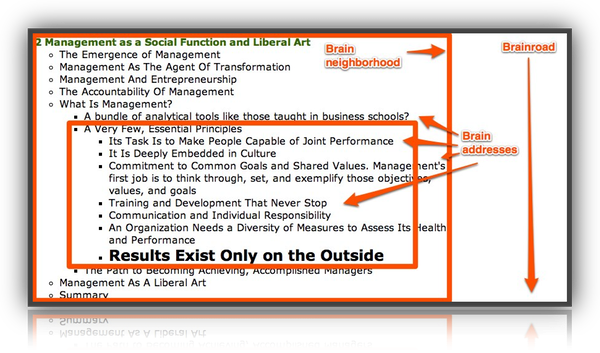
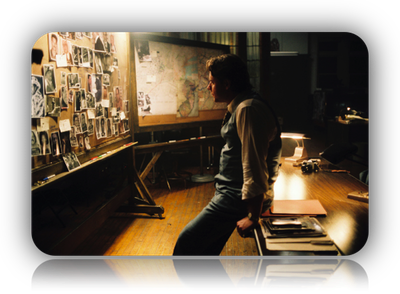
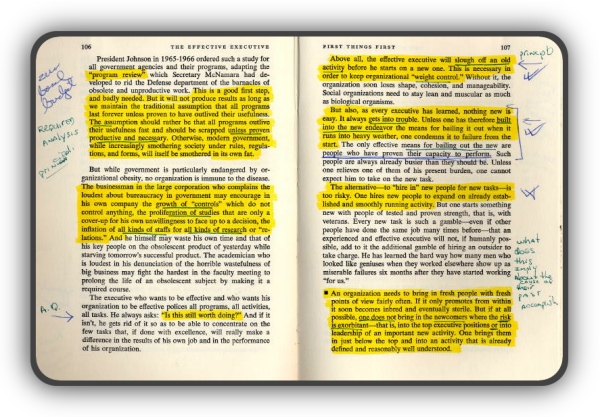
Just reading is not enough
Calendarization: From awareness to action
Dense reading and Dense listening and Thinking broad and Thinking detailed
Larger view of image below
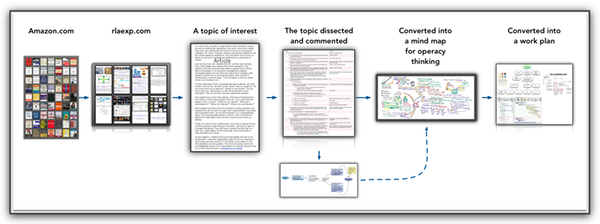
An action analysis on every sentence.
What are the implications of a particular sentence?
Dense reading and Dense Listening
Thinking broad and Thinking detailed

note the reflection ↑ and fog ↓
Challenge thinking and an alternative — operacy
Larger view
Note the fog and reflection ↓
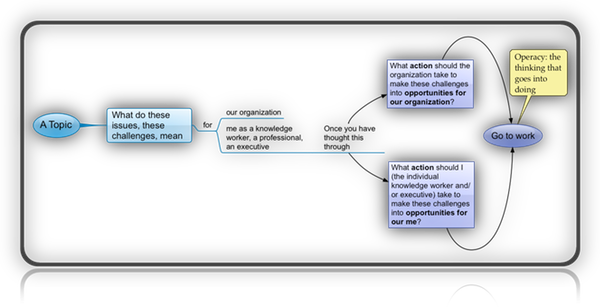
Questions ::: Thinking canvases
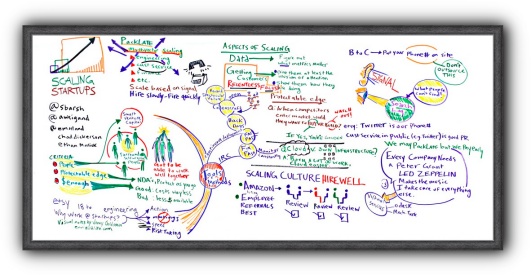
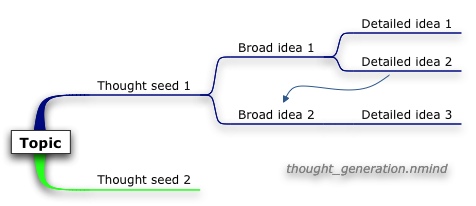
What needs doing around here?
A local view from Google Earth



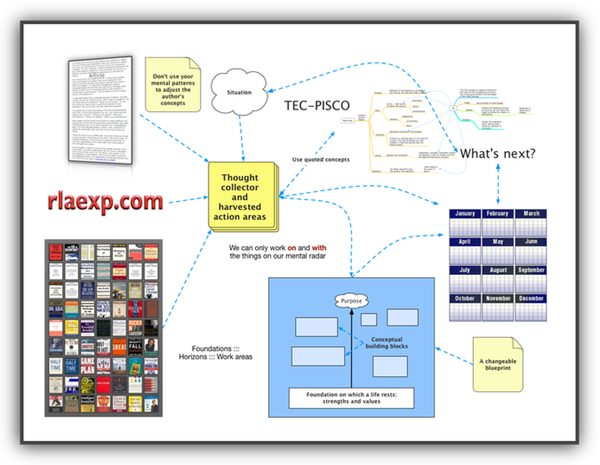
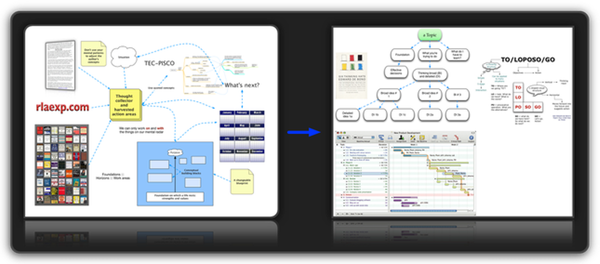
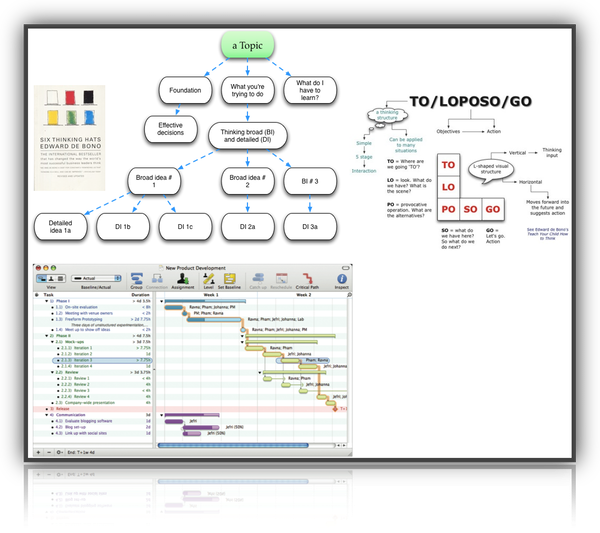

Peter Drucker’s Legacy
During a discussion in graduate school, a professor challenged my first-year class: managers and leaders — are they different?
The conversation unfolded something like this:
“Leaders set the vision; managers just figure out how to get there,” said one student.
“Leaders inspire and motivate, whereas managers keep things organized,” said another.
“Leaders elevate people to the highest values.
Managers manage the details.”
The discussion revealed an underlying worship of “leadership” and a disdain for “management.” Leaders are inspired.
Leaders are large.
Leaders are the kids with black leather jackets, sunglasses, and sheer unadulterated cool.
Managers, well, they’re the somewhat nerdy kids, decidedly less interesting, lacking charisma.
And of course, we all wanted to be leaders, and leave the drudgery of management to others.
We could not have been more misguided and juvenile in our thinking.
As Peter Drucker shows right here, in these pages, the very best leaders are first and foremost effective managers.
Those who seek to lead but fail to manage will become either irrelevant or dangerous, not only to their organizations, but to society.
Business and social entrepreneur Bob Buford once observed that Drucker contributed as much to the triumph of free society as any other individual.
I agree.
For free society to function we must have high-performing, self-governed institutions in every sector, not just in business, but equally in the social sectors.
Without that, as Drucker himself pointed out, the only workable alternative is totalitarian tyranny.
Strong institutions, in turn, depend directly on excellent management, and no individual had a greater impact on the practice of management and no single book captures its essence better than his seminal text, Management.
My first encounter with Drucker’s impact came at Stanford in the early 1990s, when Jerry Porras and I researched the great corporations of the twentieth century.
The more we dug into the formative stages and inflection points of companies like General Electric, Johnson & Johnson, Procter & Gamble, Hewlett-Packard, Merck and Motorola, the more we saw Drucker’s intellectual fingerprints.
David Packard’s notes and speeches from the foundation years at HP so mirrored Drucker’s writings that I conjured an image of Packard giving management sermons with a classic Drucker text in hand.
When we finished our research, Jerry and I struggled to name our book, rejecting more than 100 titles.
Finally in frustration I blurted, Why don’t we just name it Drucker Was Right, and we’re done!” (We later named the book Built to Last.)
What accounts for Drucker’s enormous impact?
I believe the answer lies not just in his specific ideas, but in his entire approach to ideas, composed of four elements:
1. He looked out the window, not in the mirror
2. He started first—and always—with results
3. He asked audacious questions
4. He infused all his work with a concern and compassion for the individual.
I once had a conversation with a faculty colleague about the thinkers who had influenced us.
I mentioned Drucker.
My colleague wrinkled his nose, and said: “Drucker?
But he’s so practical.”
Drucker would have loved that moment of disdain, reveling in being criticized for the fact that his ideas worked.
They worked because he derived them by precise observation of empirical facts.
He pushed always to look out there, in the world, to derive ideas, challenging himself and his students to “Look out the window, not in the mirror!”
Drucker falls in line with thinkers like Darwin, Freud and Taylor—empiricists all.
Darwin wrote copious notebooks, pages and pages about pigeons and turtles.
Freud used his therapeutic practice as a laboratory.
Taylor conducted empirical experiments, systematically tracking thousands of details.
Like them, Drucker immersed himself in empirical acts and then asked, “What underlying principle explains these facts, and how can we harness that principle?”
Drucker belonged to the church of results.
Instead of starting with an almost religious belief in a particular category of answers—a belief in leadership, or culture, or information, or innovation, or decentralization, or marketing, or strategy, or any other category—Drucker began first with the question “what accounts for superior results?” and then derived answers.
He started with the outputs—the definitions and markers of success—and worked to discover the inputs, not the other way around.
And then he preached the religion of results to his students and clients, not just to business corporations but equally to government and the social sectors.
The more noble your mission, the more he demanded: what will define superior performance?
“Good intentions,” he would seemingly yell without ever raising his voice, “are no excuse for incompetence.”
And yet while practical and empirical, Drucker never became technical or trivial, nor did he succumb to the trend in modern academia to answer (in the words of the late John Gardner) “questions of increasing irrelevance with increasing precision.”
By remaining a professor of management—not as a science, but as a liberal art he gave himself the freedom to pursue audacious questions.
My first reading of Drucker came on vacation in Monterey, California.
My wife and I embarked on one of our adventure walks through a used book store, treasure hunting for unexpected gems.
I came across a beaten-up, dog-eared copy of Concept of the Corporation, expecting a tutorial on how to build a company.
But within a few pages, I realized that it asked a much bigger question: what is the proper role of the corporation at this stage of civilization?
Drucker had been invited to observe General Motors from the inside, and the more he saw, the more disturbed he became.
“General Motors … can be seen as the triumph and the failure of the technocrat manager,” he later wrote.
“In terms of sales and profits [GM) has succeeded admirably … But it has also failed abysmally—in terms of public reputation, of public esteem, of acceptance by the public.”
Drucker passionately believed in management not as a technocratic exercise, but as a profession with a noble calling, just like the very best of medicine and law.
Drucker could be acerbic and impatient, a curmudgeon.
But behind the prickly surface, and behind every page in his works, stands a man with tremendous compassion for the individual.
He sought not just to make our economy more productive, but to make all of society more productive and more humane.
To view other human beings as merely a means to an end, rather than as ends in themselves, struck Drucker as profoundly immoral.
And as much as he wrote about institutions and society, I believe that he cared most deeply about the individual.
I personally experienced Drucker’s concern and compassion in 1994, when I found myself at a crossroads, trying to decide whether to jettison a traditional path in favor of carving my own.
I mentioned to an editor for Industry Week that I admired Peter Drucker.
“I recently interviewed Peter,” he said, “and I’d be happy to ask if he’d be willing to spend some time with you.”
I never expected anything to come of it, but one day I got a message on my answering machine.
“This is Peter Drucker”—slow, deliberate, in an Austrian accent—"I would be very pleased to spend a day with you, Mr. Collins.
Please give me a call.”
We set a date for December, and I flew to Claremont, California.
Drucker welcomed me into his home, enveloping my extended hand into two of his.
“Mr. Collins, so very pleased to meet you.
Please come inside.”
He invested the better part of a day sitting in his favorite wicker chair, asking questions, teaching, guiding, and challenging.
I made a pilgrimage to Claremont seeking wisdom from the greatest management thinker, and I came away feeling that I’d met a compassionate and generous human being who—almost as a side benefit—was a prolific genius.
There are two ways to change the world: the pen (the use of ideas) and the sword (the use of power).
Drucker chose the pen, and thereby rewired the brains of thousands who carry the sword.
Those who choose the pen have an advantage over those who wield the sword: the written word never dies.
If you never had the privilege to meet Peter Drucker during his lifetime, you can get to know him in these pages.
You can converse with him.
You can write notes to him in the margins.
You can argue with him, be irritated by him, and inspired.
He can mentor you, if you let him, teach you, challenge you, change you—and through you, the world you touch. (calendarize this)
Peter Drucker shined a light in a dark and chaotic world, and his words remain as relevant today as when he banged them out on his cranky typewriter decades ago.
They deserve to be read by every person of responsibility, now, tomorrow, ten years from now, fifty and a hundred.
That free society triumphed in the twentieth century guarantees nothing about its triumph in the twenty-first; centralized tyranny remains a potent rival, and the weight of history is not on our side.
When young people ask, “What can I do to make a difference?” one of the best answers lies right here in this book.
Get your hands on an organization aligned with your passion, if not in business, then in the social sectors.
If you can’t find one, start one.
And then lead it—through the practice of management—to deliver extraordinary results and to make such a distinctive impact that you multiply your own impact by a thousand-fold. (calendarize this?)
Jim Collins
Boulder, Colorado
December, 2007
Preface
What will future historians consider the most important event of the twentieth century:
The two World Wars?
The atomic bomb?
The rise of Japan to be the first non-Western great economic power?
The information revolution?
The demographic revolutions that occurred in the twentieth century—revolutions that have profoundly changed the world’s human landscape and that have no precedents.
And I mean not only the quantitative change: the explosive growth of population in the twentieth century and the equally explosive extension of life spans resulting in an aging population in all developed and in most emerging countries.
Equally important, indeed perhaps more important, was the qualitative change: the unprecedented transformation of the workforce in all developed countries, from one doing largely unskilled, manual work, to one doing knowledge work.
At the beginning of the twentieth century, ninety out of every hundred people in the working population in every country were manual workers, farmers and their hired hands, domestic servants, factory workers, miners, or construction workers.
And life expectancies, especially work-life expectancies, were so low that a majority of working people were disabled well before they reached what was then the threshold of old age, that is, age fifty.
But while the life expectancy of the individual and especially the individual knowledge worker has risen beyond anything anybody could have foretold at the beginning of the twentieth century, the life expectancy of the employing institution has been going down, and is likely to keep going down.
Or rather, the number of years has been shrinking during which an employing institution—and especially a business enterprise—can expect to stay successful.
This period was never very long.
Historically, very few businesses were successful for as long as thirty years in a row.
To be sure, not all businesses ceased to exist when they ceased to do well.
But the ones that survived beyond thirty years usually entered into a long period of stagnation—and only rarely did they turn around again and once more become successful growth businesses.
Thus, while the life expectancies and especially the working-life expectancies of the individual and especially of the knowledge worker have been expanding very rapidly, the life expectancy of the employing organizations has actually been going down.
And—in a period of very rapid technological change, of increasing competition because of globalization, of tremendous innovation—the successful life-expectancies of employing institutions are almost certain to continue to go down.
More and more people, and especially knowledge workers, can therefore expect to outlive their employing organizations and to have to be prepared to develop new careers, new skills, new social identities, new relationships, for the second half of their lives.
And now the largest single group in the workforce in all developed countries is knowledge workers rather than manual workers.
At the beginning of the twentieth century, knowledge workers in any country, even the most highly developed ones, were very scarce.
I doubt that there was any country in which they exceeded 2 or 3 percent of the working population.
Now, in the United States, they account for around 33 percent of the working population.
By the year 2020, they will account for about the same proportion in Japan and in Western Europe.
They are something we have never seen before.
These knowledge workers own their means of production, for they own their knowledge.
And their knowledge is portable; it is between their ears.
For untold millennia, there were no choices for the overwhelming majority of people in any country.
A farmer’s son became a farmer.
A craftsman’s son became a craftsman, and a craftsman’s daughter married a craftsman; a factory worker’s son or daughter went to work in a factory.
Whatever mobility there was was downward mobility.
In the 250 years of Tokugawa rule in Japan, for instance, very few people advanced from being commoners to being samurai—that is, privileged warriors.
An enormous number of samurai, however, lost their status and became commoners, that is, moved down.
The same was true all over the world.
Even in the most mobile of countries, the early twentieth-century United States, upward mobility was still the exception.
We have figures from the early 1900s until 1950 or 1955.
They show conclusively that at least nine out of every ten executives and professionals were themselves the sons of executives and professionals.
Only one out of every ten executives or professionals came from the “lower orders” (as they were then called).
The business enterprise, as it was invented around 1860 or 1870—and it was an invention that had little precedent in history—was such a radical innovation precisely because there was upward mobility within it for a few people.
This was the reason why the business enterprise ruptured the old communities—the rural village, the small town, or the craft guild.
But even the business enterprise, as it was first developed, tried to become a traditional community.
It is commonly believed—in Japan as well as in the West—that the large Japanese company with its lifetime employment is some thing that exists only in Japan and expresses specific Japanese values.
Apart from the fact that this is historical nonsense—lifetime employment in Japan even for white collar, salaried employees was a twentieth-century invention and did not exist before the end of Meiji (that is, before the twentieth century)—the large business enterprise in the West was not very different.
Anyone who worked as a salaried employee for a large company in Germany, Great Britain, the United States, Switzerland, and so on had, in effect, lifetime employment.
And even a salaried employee above the entry level in such a company considered himself “a company man” and identified himself with the company.
He—and of course in those days they were all men—was a “Siemens Man” in Germany or a “General Electric Man” in the United States.
Most of the big companies all over the West, just like the Japanese companies, hired people for only the entrance positions, and they expected them to stay until they died or retired.
In fact, the Germans, with their passion for codifying everything, even created a category for such people.
They were called “private civil servants” (Privatbeamte).
Socially, they ranked below civil servants.
But legally, they had the same job security and, in effect, lifetime employment—with the implicit assumption that they, in turn, would be committed to their employer for their entire working life and career.
The Japanese company as it was finally formulated in the 1950s or early 1960s was, in other words, simply the most highly structured and most visible expression of the large business enterprise as it had been first developed in the late nineteenth-century and then reached full maturity in the first half of the twentieth century.
The early nineteenth-century business—and even the mid-nineteenth-century business—derived success from low costs.
Successfully managing a business meant being able to produce the same commodities everybody else produced but at lower cost.
In the twentieth century this then changed to what we now call “strategy” or analysis for the purpose of creating competitive advantage.
I may claim to have been the first one to point this out, in a 1964 book called Managing for Results.
But by that time a shift was already underway to another basic foundation: knowledge.
I had realized that in 1959—and the first result of this realization was my book The Effective Executive (1966).
It was in that book that the shift to the knowledge worker was foreshadowed and its implication for the business first analyzed.
The knowledge worker, to repeat, differs from any earlier worker in two major aspects.
First, the knowledge worker owns the means of production and they are portable.
Second, he or she is likely to outlive any employing organization.
Add to this that knowledge work is very different in character from earlier forms of work.
It is effective only if highly specialized.
What makes a brain surgeon effective is that he is a specialist in brain surgery.
By the same token, however, he probably could not repair a damaged knee.
And he certainly would be helpless if confronted with a tropical parasite in the blood.
This is true for all knowledge work.
“Generalists”—and this is what the traditional business enterprise, including the Japanese companies, tried to develop—are of limited use in a knowledge economy.
In fact, they are productive only if they themselves become specialists in managing knowledge and knowledge workers.
This, however, also means that knowledge workers, no matter how much we talk about “loyalty,” will increasingly and of necessity see their knowledge area—that is, their specialization rather than the employing organization—as what identifies and characterizes them.
Their community will increasingly be people who share the same highly specialized knowledge, no matter where they work or for whom.
In the United States, as late as the 1950s or 1960s, when meeting somebody at a party and asking him what he did, one would get the answer, “I work for General Electric” or “for Citibank” or for some other employing organization.
In other words, one would get exactly the same kind of answer in Germany, in Great Britain, in France, and in any other developed country.
Today, in the United States, if one asks someone whom one meets at a party, “What do you do?” the answer is likely to be, “I am a metallurgist” or “I am a tax specialist” or “I am a software designer.”
In other words, in the United States, at least, knowledge workers no longer identify themselves with an employer.
They identify themselves with a knowledge area.
The same is increasingly true in Japan, certainly among the younger people.
This is more likely to change the organization of the future, and especially the business enterprise, than technology, information, or e-commerce.
Since 1959, when I first realized that this change was about to happen, I consciously worked at thinking through the meaning of this tremendous change, and especially the meaning for individuals.
For not only is it individuals who will have to convert this change into opportunity for themselves, for their careers, for their achievement, for their identification and fulfillment.
It is the individual knowledge worker who, in large measure, will determine what the organization of the future will look like and which kind of organization of the future will be successful. (calendarize this?)
What do you want to be remembered for?
There is as a consequence only one satisfactory definition of management, whether we talk of a business, a government agency, or a nonprofit organization: to make human resources productive. (the contents of this book spread over decades through several stages of development)
It will increasingly be the only way to gain competitive advantage.
Of the traditional resources of the economist—land, labor, and capital—none anymore truly confers a competitive advantage.
To be sure, not to be able to use these resources as well as anyone else is a tremendous competitive disadvantage.
But every business has access to the same raw materials at the same price.
Access to money is worldwide.
And manual labor, the traditional third resource, has become a relatively unimportant factor in most enterprises.
Even in traditional manufacturing industries, labor costs are no more than 12 or 13 percent of total costs, so that even a very substantial advantage in labor costs (say a 5 percent advantage) results in a negligible competitive advantage except in a very small and shrinking number of highly labor-intensive industries (e.g., knitting woolen sweaters).
The only meaningful competitive advantage is the productivity of the knowledge worker.
And that is very largely in the hands of the knowledge worker rather than in the hands of management.
Knowledge workers will increasingly determine the shape of the successful employing organizations.
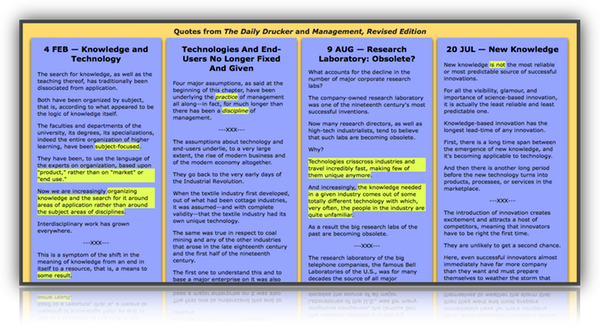
Larger
What this implies is basically the topic of this book.
These are very new demands.
To satisfy them will increasingly be the key to success and survival for the individual and enterprise alike.
To enable its readers to be among the successes—as executives in their organization, in managing themselves and others—is the primary aim of the revised edition of this book.
I suggest you read one chapter at a time—it is a long book.
And then first ask, “What do these issues, these challenges, mean for our organization and for me as a knowledge worker, a professional, an executive?”
Once you have thought this through, ask,
“What action should our organization and I, the individual knowledge worker and/or executive, take to make the challenges of this chapter into opportunities for our organization and me?”
What management will we need from here on out? When do we start? And after that?
Organization Evolution

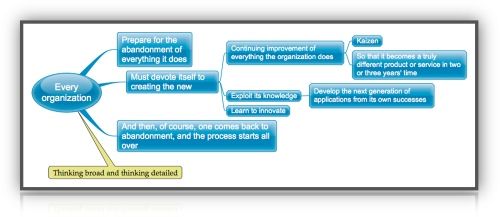
Larger view
Thinking Broad and Thinking Detailed
The concepts and ideas presented here represent “constitutional” thinking.
They are not just “tips” to be layered on existing operations and activities.
There are multiple time dimensions here.
Consider the life story of Apple.
As they were doing things
they were embedded in a world doing things.
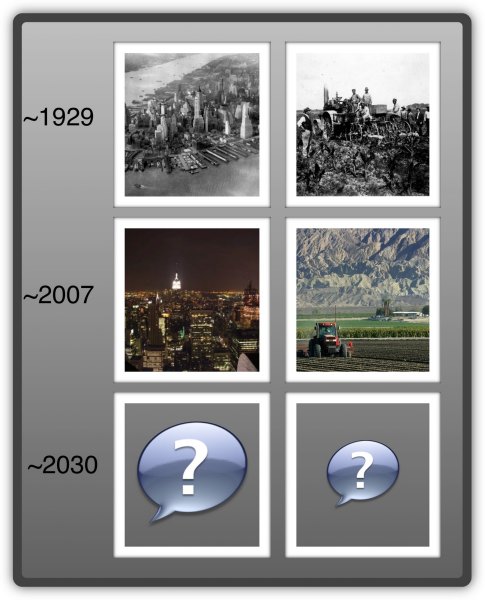
Calendarize this book? Concepts to daily action
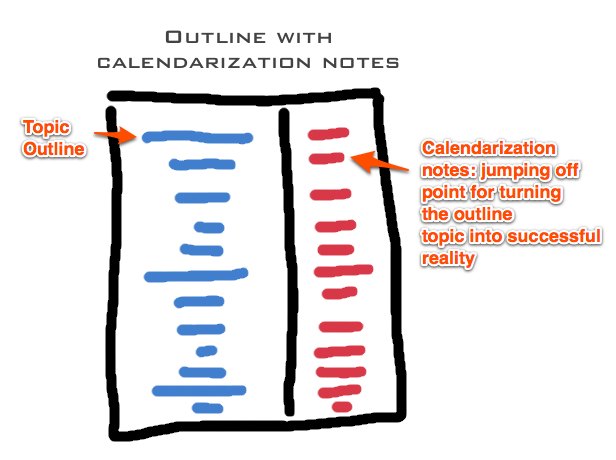
Also see Built to Last: Successful Habits of Visionary Companies by Jim Collins and Jerry I. Porras and
Good to Great: Why Some Companies Make the Leap … and Others Don’t
Management is a discipline and a practice
It is polycentric—it has many centers and interrelated elements.
It is, therefore, very difficult to master this subject by mastering individual chapters in a linear way.
One must integrate the elements into a working framework, as the whole is greater and different than the sum of its parts.
Each of the ten parts of this book is related to one or more other parts.
Each chapter is a part of the whole—the “words—but the music, if you will, comes from seeing management as an organic whole.
This introduction describes these interrelated elements of management as a system.
Figure 1 provides a road map that relates each element to the whole subject.
Each element is the subject of one or more chapters in this book.
Seek to understand and apply the subject of management as an organic whole and not merely as a set of isolated elements.
This portrayal of management as an organic whole is consistent with the view expressed in the original text where Peter Drucker explains the nature of organizations and management:
There is one fundamental insight underlying all management science.
It is that the business enterprise is a system of the highest order: a system the parts of which are human beings contributing voluntarily of their knowledge, skill, and dedication to a joint venture.
And one thing characterizes all genuine systems, whether they be mechanical, like the control of a missile, biological like a tree, or social like the business enterprise:
it is interdependence.
The whole of a system is not necessarily improved if one particular function or part is improved or made more efficient.
In fact, the system may well be damaged thereby, or even destroyed.
In some cases the best way to strengthen the system may be to weaken a part—to make it less precise or less efficient.
For what matters in any system is the performance of the whole; this is the result of growth and of dynamic balance, adjustment, and integration rather than of mere technical efficiency (p. 508, Management: Tasks, Responsibilities, Practices).
Figure 1 provides a systems view of this revised edition.
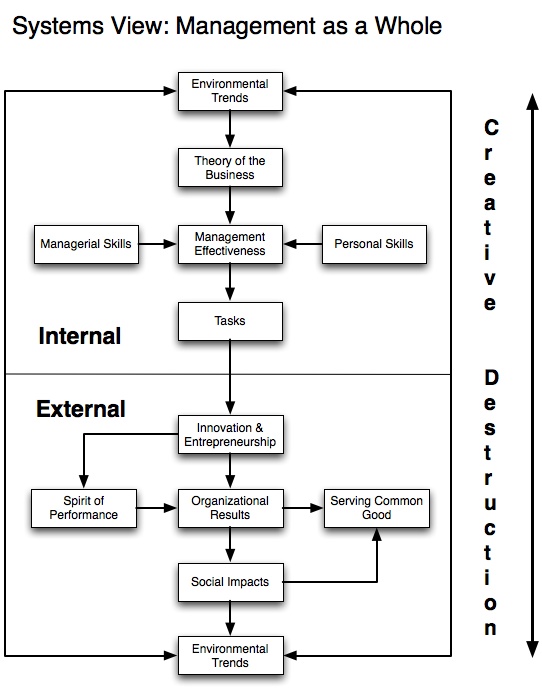
The diagram and the material in this chapter will help you navigate, absorb, and apply the material contained in this book.
The elements and chapters in the book are most effectively viewed as an organic whole, an interrelated system of elements that encompass responsibilities, tasks, and practices.
These elements taken together create the basis for the practice of management.
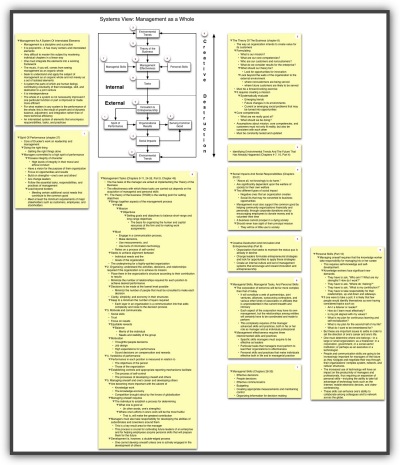
Larger
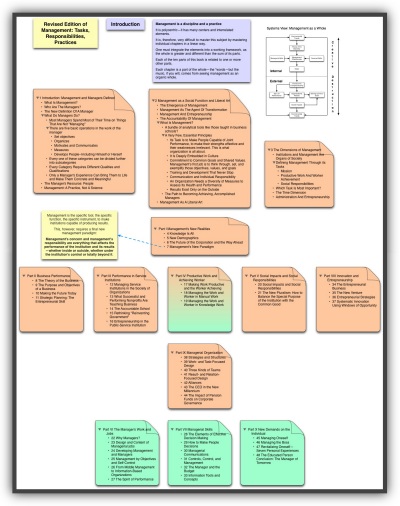
Larger
As much as I admire this work, the material above is not the complete story — see below. Try to make sure that you don’t bring a knife to gun fight — Zune ™ vs. iPod ™

The following ↓ is a condensed strategic brainscape that can be explored and modified to fit a user’s needs
The concepts and links below ↓ are …
major foundations ↓ for future directed decisionS
aimed at navigating
a world constantly moving toward unimagined futureS ↓
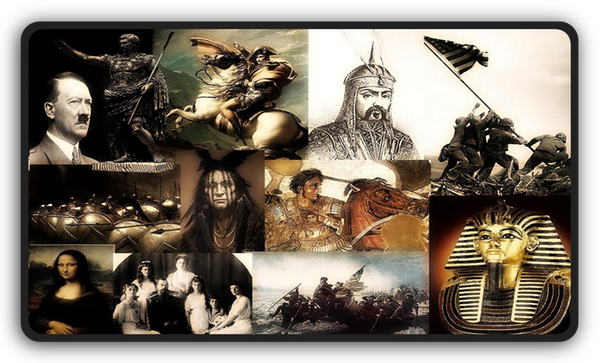
YouTube: The History of the World in Two Hours
— beginning with the industrial revolution ↑ ↓
Management and the World’s Work
↑ In less than 150 years, management ↑ has transformed
the social and economic fabric of the world’s developed countries …
“Your thinking, choices, decisions are determined by
what you have seen” edb
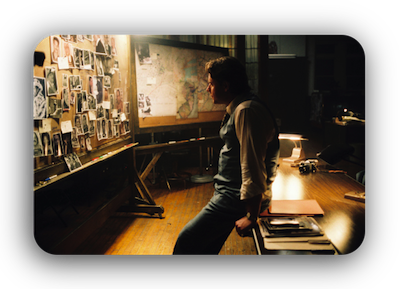
Take responsibility for yourself and
don’t depend on any one organization ↑ ↓ (bread-crumb trailS below)
We can only work on the thingS on our mental radar ↑ at a point in time ↓
About time ↓ The future that has already happened
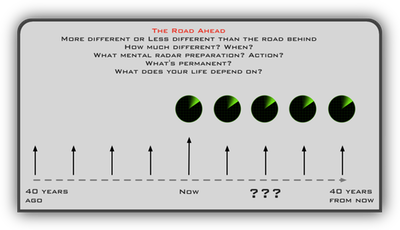
The economic and social health of our world
depends on
our capacity to navigate unimagined futureS
(and not be prisoners of the past)
The assumption that tomorrow is going to be
an extrapolation of yesterday sabotages the future — an
organization’s, a community’s and a nation’s future.
The assumption ↑ sabotages future generations — your children’s,
your grandchildren’s and your great grandchildren’s — in
spite of what the politicians say …
The vast majority of organization and political power structures
are engaged in this ↑ futile mind-set …
while rationalizing the evidence
The future is unpredictable and that means
it ain’t going to be like today
(which was designed & produced yesterday)
The capacity to navigate is governed by what’s between our ears ↑ ↓

When we are involved in doing something ↑
it is extremely difficult to navigate
and very easy to become a prisoner of the past.
We need to maintain a pre-thought ↓
systematic approach to work and work approach ↓
Click on either side of the image below to see a larger view
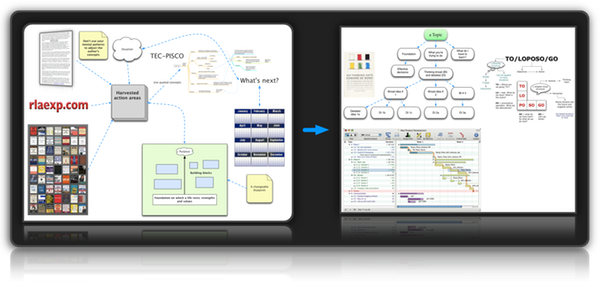
based on reality →
the non-linearity of time and events
and the unpredictability of the future
with its unimagined natureS. ↓ ↑
(It’s just a matter of time before we can’t get to the future
from where we are presently)
Foundations and opportunities ::: larger view ↓
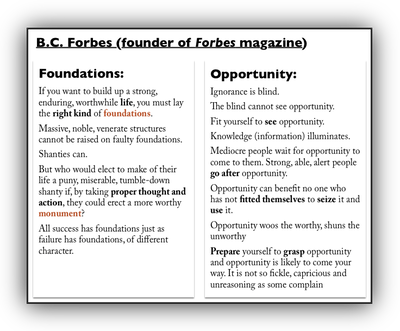
Intelligence and behavior ↑ ↓ ← Niccolò Machiavelli ↑ ↓
Political ecologists believe that the traditional disciplines define fairly narrow and limited tools rather than meaningful and self-contained areas of knowledge, action, and events … continue
❡ ❡ ❡
Foundational ↑ Books → The Lessons of History — unfolding realities (The New Pluralism → in Landmarks of Tomorrow ::: in Frontiers of Management ::: How Can Government Function? ::: the need for a political and social theory ::: toward a theory of organizations then un-centralizing plus victims of success) ::: The Essential Drucker — your horizons? ::: Textbook of Wisdom — conceptual vision and imagination tools ::: The Daily Drucker — conceptual breadth ::: Management Cases (Revised Edition) see chapter titles for examples of “named” situations …

What do these ideas, concepts, horizons mean for me? continue
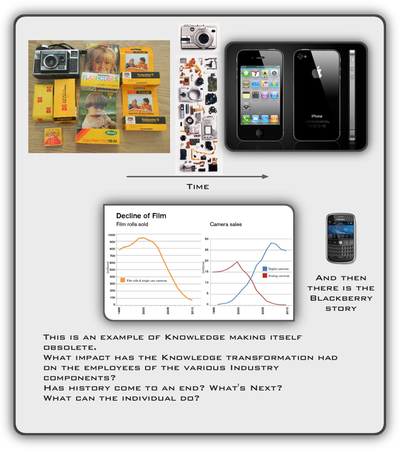
Society of Organizations
“Corporations once built to last like pyramids
are now more like tents.
Tomorrow they’re gone or in turmoil.”

“The failure to understand the nature, function, and
purpose of business enterprise” Chapter 9, Management Revised Edition
“The customer never buys ↑ what you think you sell.
And you don’t know it.
That’s why it’s so difficult to differentiate yourself.” Druckerism
“People in any organization are always attached to the obsolete —
the things that should have worked but did not,
the things that once were productive and no longer are.” Druckerism
Why Peter Drucker Distrusted Facts (HBR blog) and here
Best people working on the wrong things continue
Conditions for survival
Going outside
Making the future — a chance for survival ↑
“For what should America’s new owners, the pension funds,
hold corporate management accountable?” and
“Rather, they maximize the wealth-producing capacity of the enterprise”
Search for the quotes above here
Successful careerS are not planned ↑ here and ↓
What do these issues, these challenges mean for me & … — an alternative
Exploration paths → The memo they don’t want you to see ::: Peter Drucker — top of the food chain ::: Work life foundations (links to Managing Oneself) ::: A century of social transformation ::: Post-capitalist executive interview ::: Allocating your life ::: What executives should remember ::: What makes an effective executive? ::: Innovation ::: Patriotism is not enough → citizenship is needed ::: Drucker’s “Time” and “Toward tomorrowS” books ::: Concepts (a WIP) ::: Site map a.k.a. brainscape, thoughtscape, timescape
Just reading ↑ is not enough, harvesting and action thinking are needed … continue
Information ↑ is not enough, thinking ↓ is needed … first then next + critical thinking
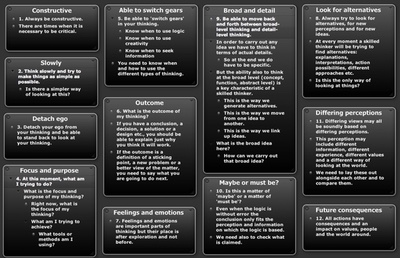
Larger view of thinking principles ↑ Text version ↑ :::
Always be constructive ↑ What additional thinking is needed?
Initially and absolutely needed: the willingness and capacity to
regularly look outside of current mental involvements continue
bread-crumb trail end

Peter Drucker: Conceptual Resources
The Über Mentor
A political / social ecologist
a different way of seeing and thinking about
the big picture
— lead to his top-of-the-food-chain reputation

about Management (a shock to the system)
“I am not a ‘theoretician’; through my consulting practice I am in daily touch with the concrete opportunities and problems of a fairly large number of institutions, foremost among them businesses but also hospitals, government agencies and public-service institutions such as museums and universities.
And I am working with such institutions on several continents: North America, including Canada and Mexico; Latin America; Europe; Japan and South East Asia.” — PFD

List of his books
Large combined outline of Drucker’s books — useful for topic searching.

“High tech is living in the nineteenth century,
the pre-management world.
They believe that people pay for technology.
They have a romance with technology.
But people don't pay for technology:
they pay for what they get out of technology.” —
The Frontiers of Management
TLN Keywords: tlnkwmanagement, tlnkwdruckerbook
|
![]()
